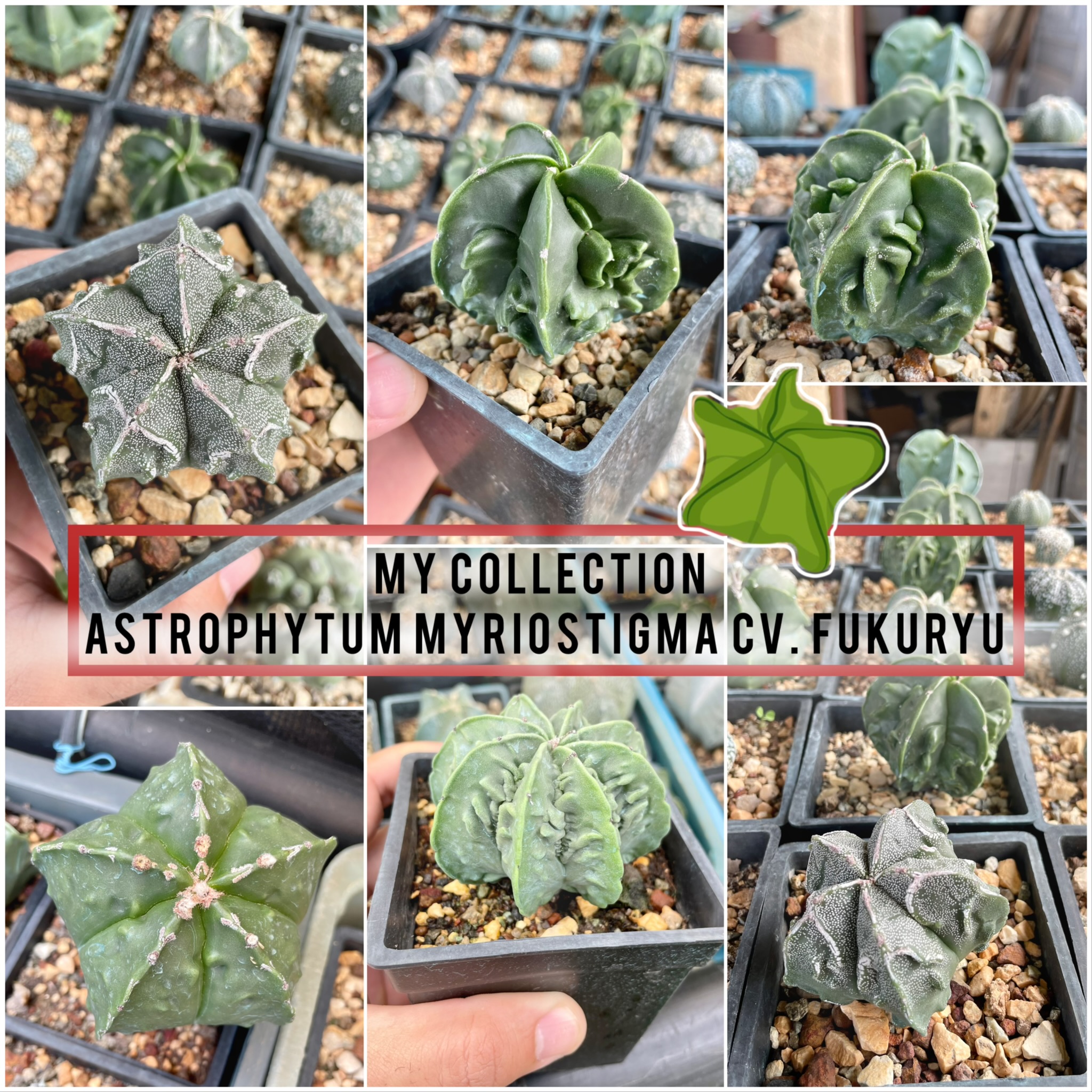
Hello…. Good evening, plant and succulent lovers!! I've been looking forward to posting with you all for days, the Succulent Growers community led by @nikv. Today, I want to share some specimens from my collection of Astrophytum myriostigma cv. Fukuryu, including the most treasured and curious ones in my garden. I really hope you like them and that you enjoy the following images. 🤗
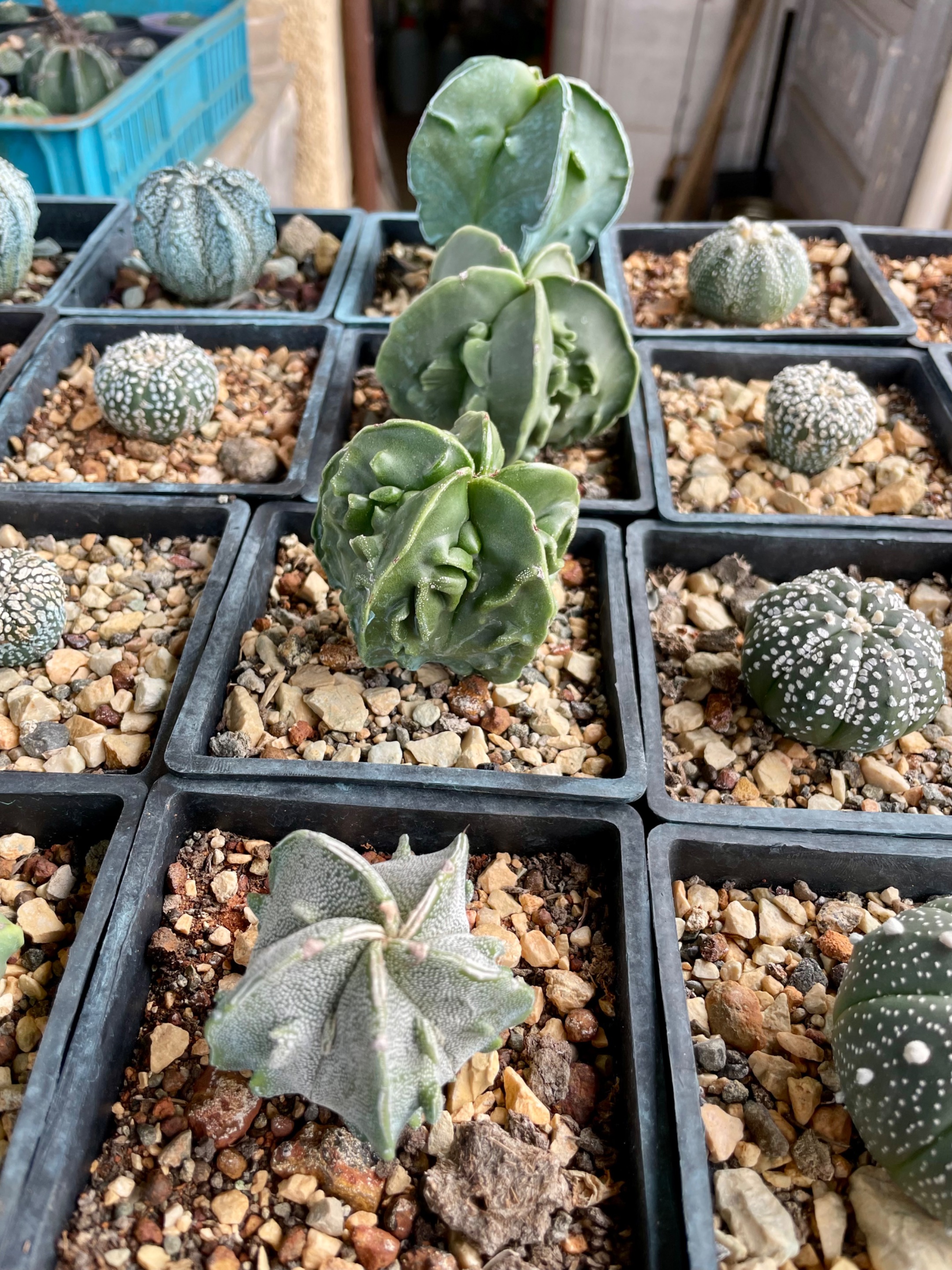
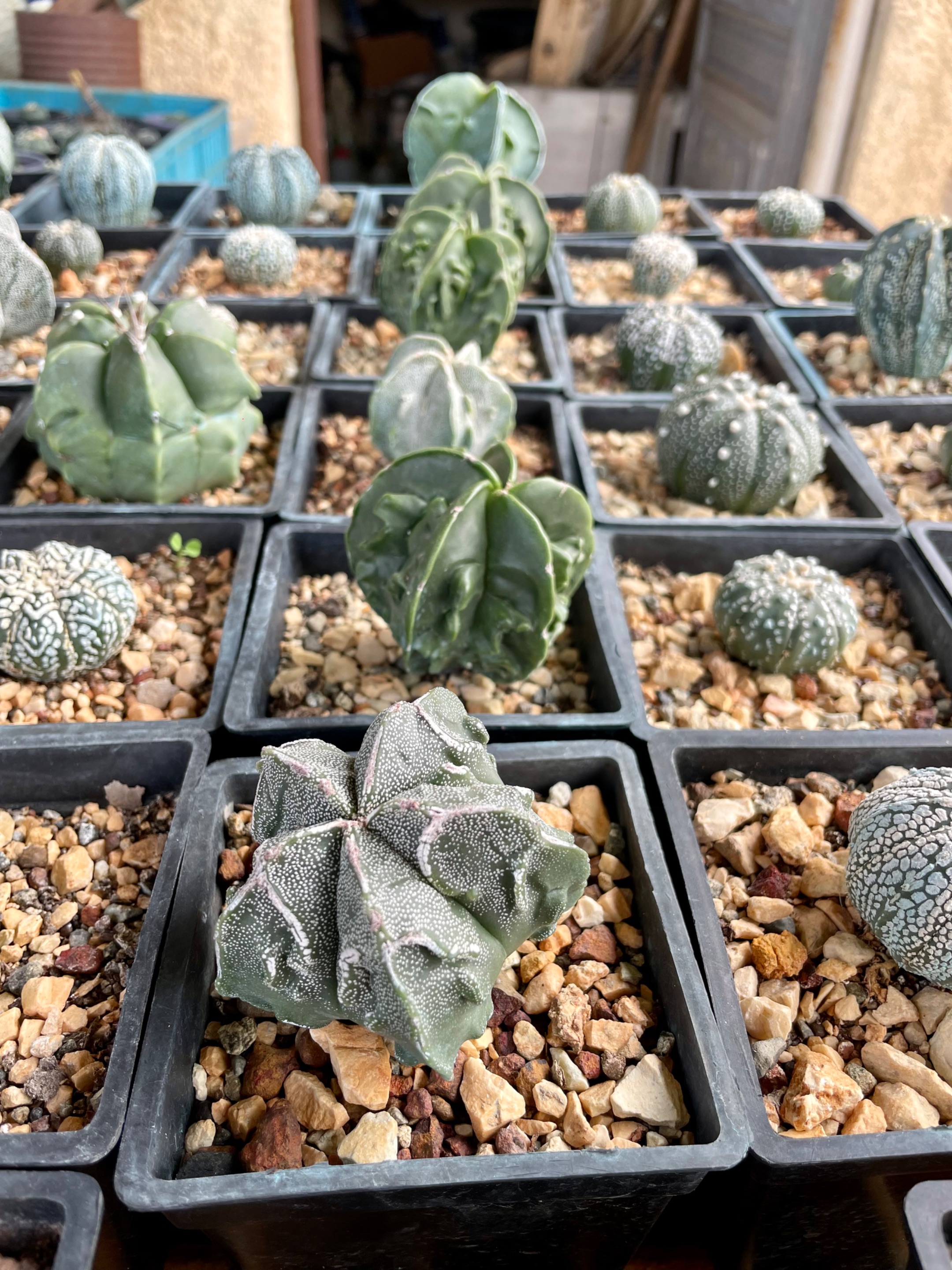 ---
Astrophytum myriostigma cv. Fukuryu often have a unique and exceptional shape. As I mentioned in previous posts, these exotic, star-shaped and globular cacti—which become columnar over time—are loved by collectors. The name of this variety, Fukuryu comes from a Japanese word meaning "the presence of extra ribs," and it can be found in two very distinct forms:
Type A: With small, additional ribs that do not reach the plant's apex and develop between its true ribs.
Type B: The plant has many more ribs or warts between and on its surface.
---
Astrophytum myriostigma cv. Fukuryu often have a unique and exceptional shape. As I mentioned in previous posts, these exotic, star-shaped and globular cacti—which become columnar over time—are loved by collectors. The name of this variety, Fukuryu comes from a Japanese word meaning "the presence of extra ribs," and it can be found in two very distinct forms:
Type A: With small, additional ribs that do not reach the plant's apex and develop between its true ribs.
Type B: The plant has many more ribs or warts between and on its surface.
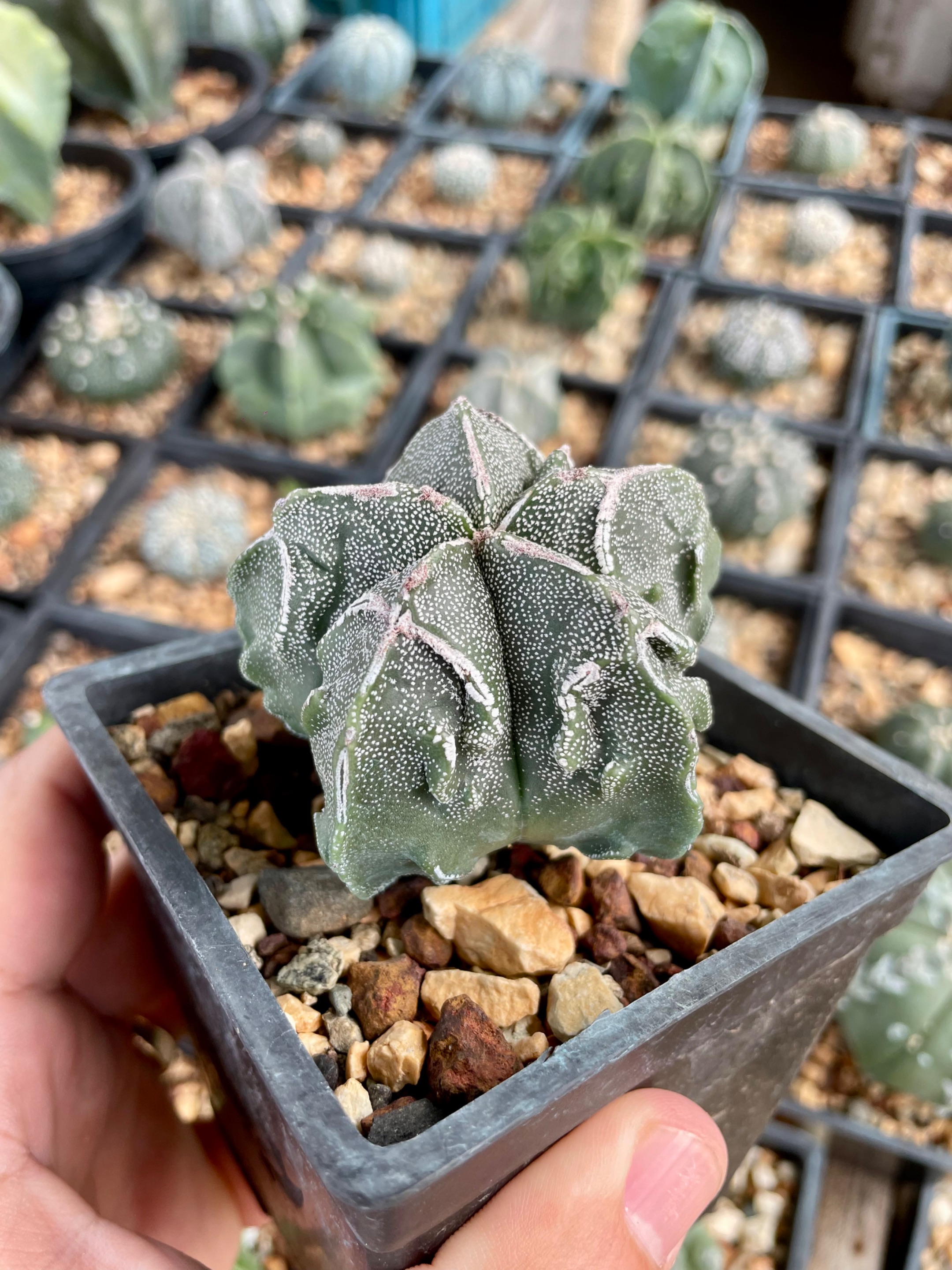
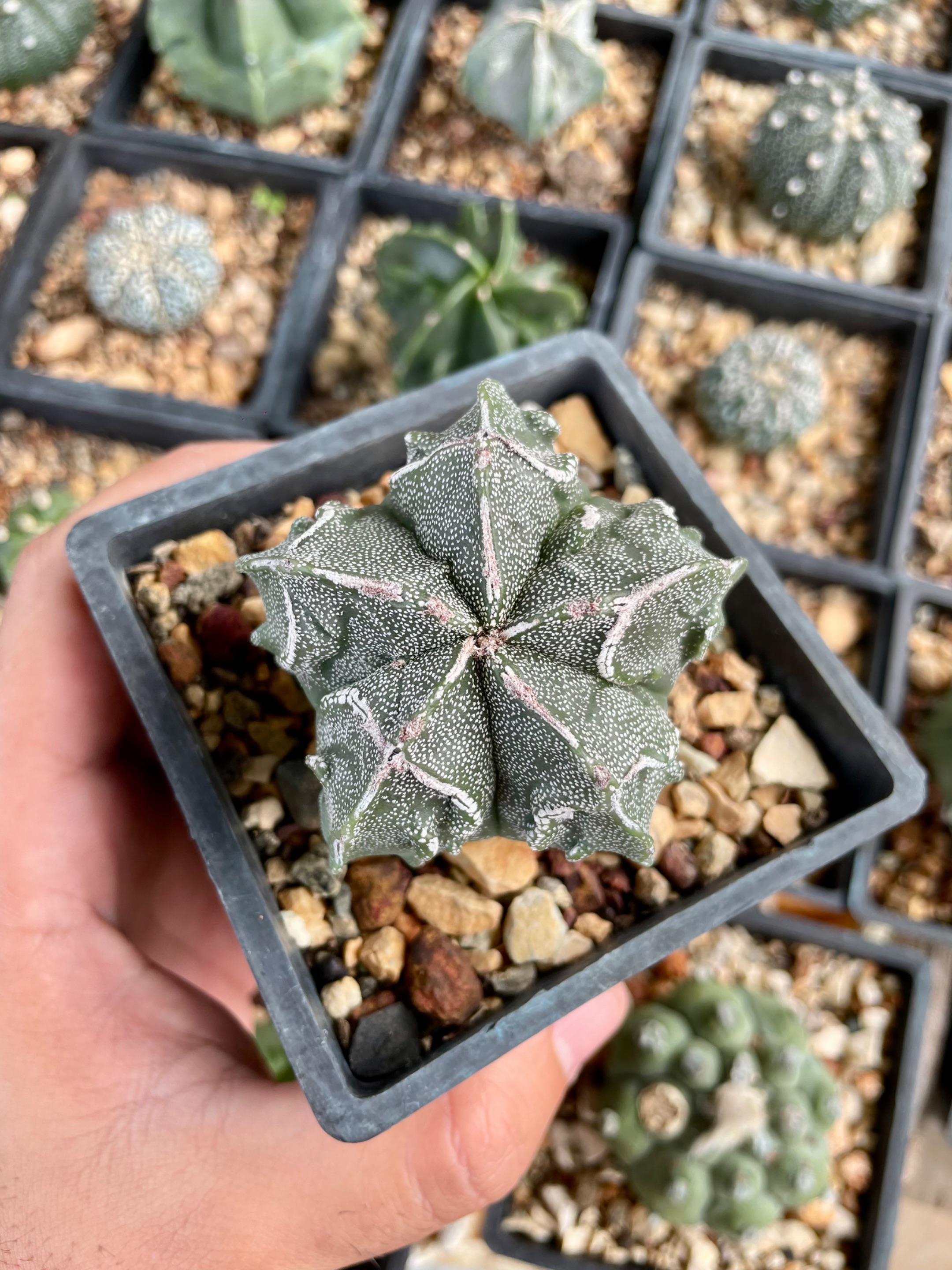 ---
Many of these Astrophytum are germinated and cultivated from seeds in my nursery. As you can see, their areoles are usually small and they may have no spines or just a few short ones.
They break the perfect geometry of the common myriostigma, giving it a rugged, monstrous look that can perfectly resemble the scales on a dragon's back.
---
Many of these Astrophytum are germinated and cultivated from seeds in my nursery. As you can see, their areoles are usually small and they may have no spines or just a few short ones.
They break the perfect geometry of the common myriostigma, giving it a rugged, monstrous look that can perfectly resemble the scales on a dragon's back.
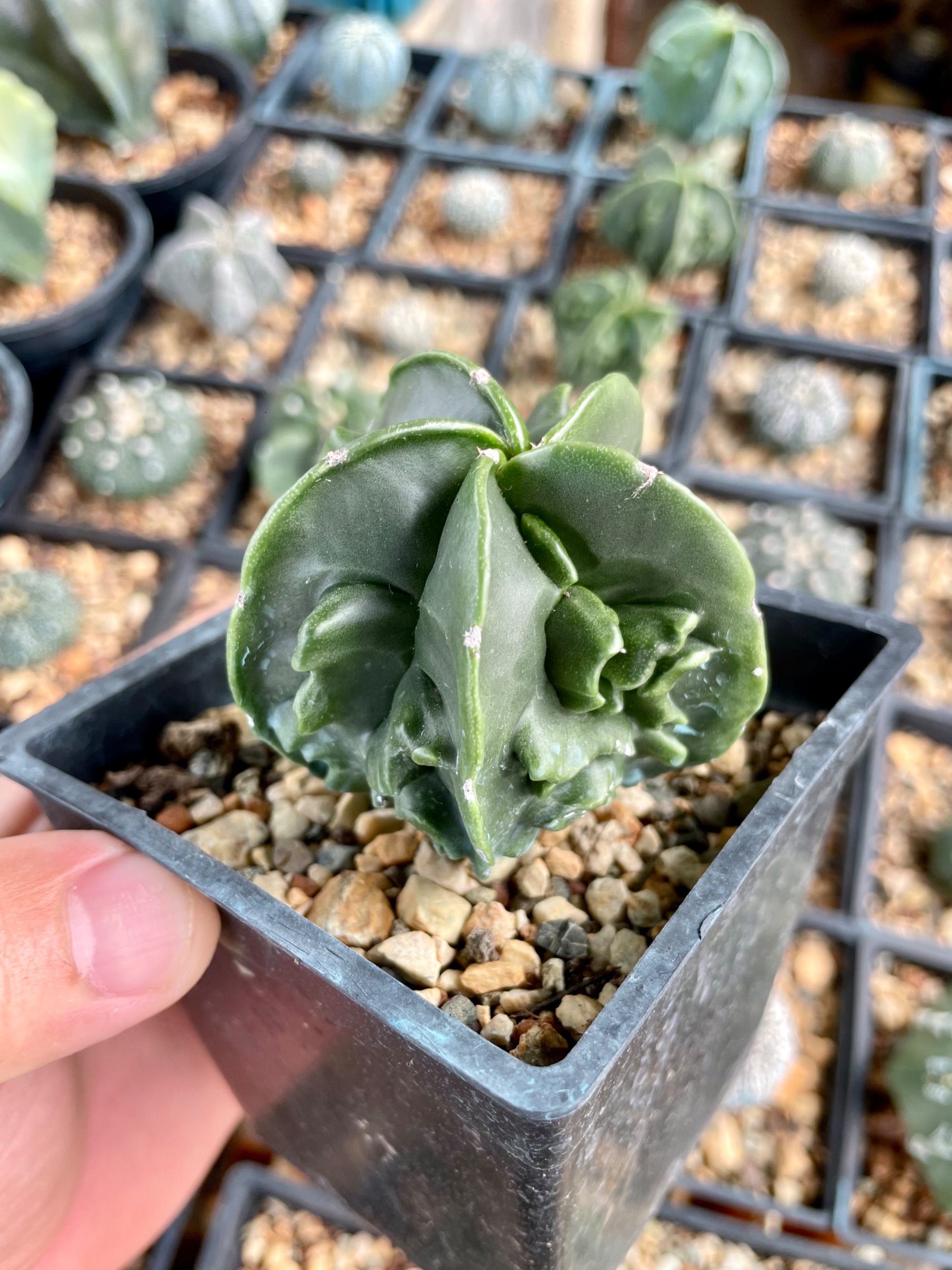
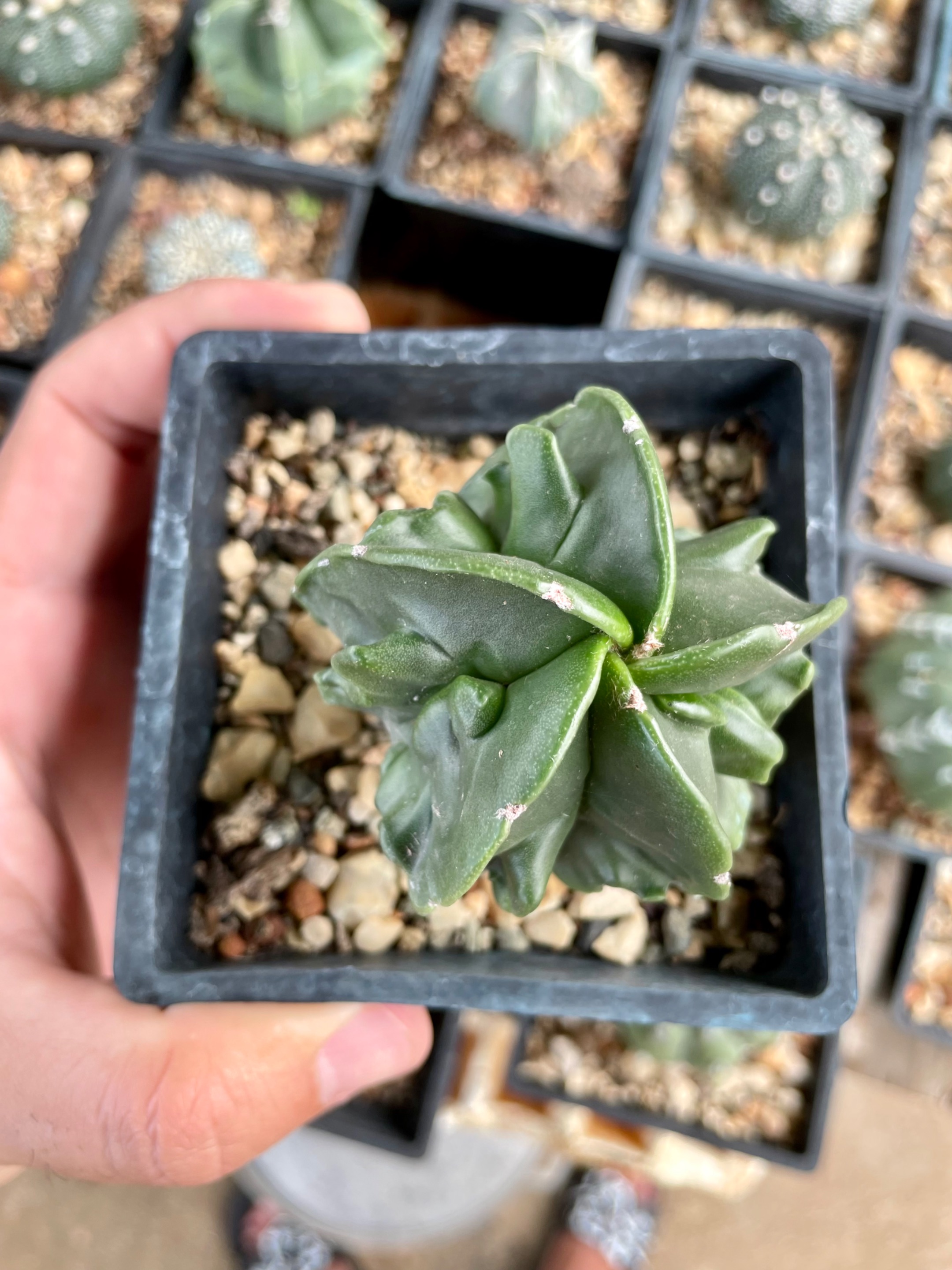
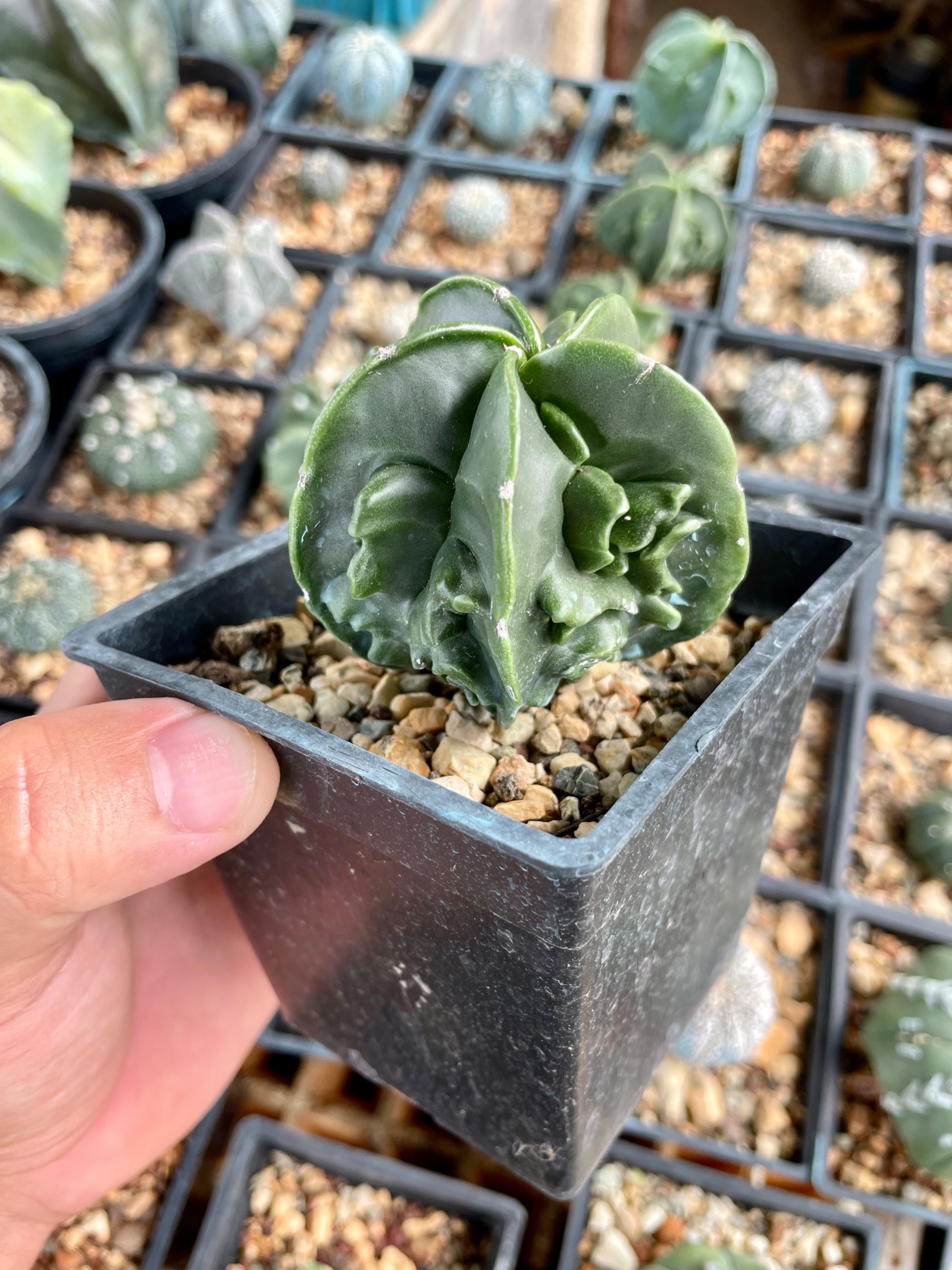 ---
Fukuryu flowers can be relatively large, funnel-shaped, and come in shades of yellow, orange, red, etc. They bloom during sunny seasons like spring and summer, but direct contact with the plant should be avoided.
They are drought-tolerant. However, during the growing period, adequate watering is necessary to keep the soil moist. In winter, it is best to reduce watering to prevent water accumulation and root rot.
---
Fukuryu flowers can be relatively large, funnel-shaped, and come in shades of yellow, orange, red, etc. They bloom during sunny seasons like spring and summer, but direct contact with the plant should be avoided.
They are drought-tolerant. However, during the growing period, adequate watering is necessary to keep the soil moist. In winter, it is best to reduce watering to prevent water accumulation and root rot.
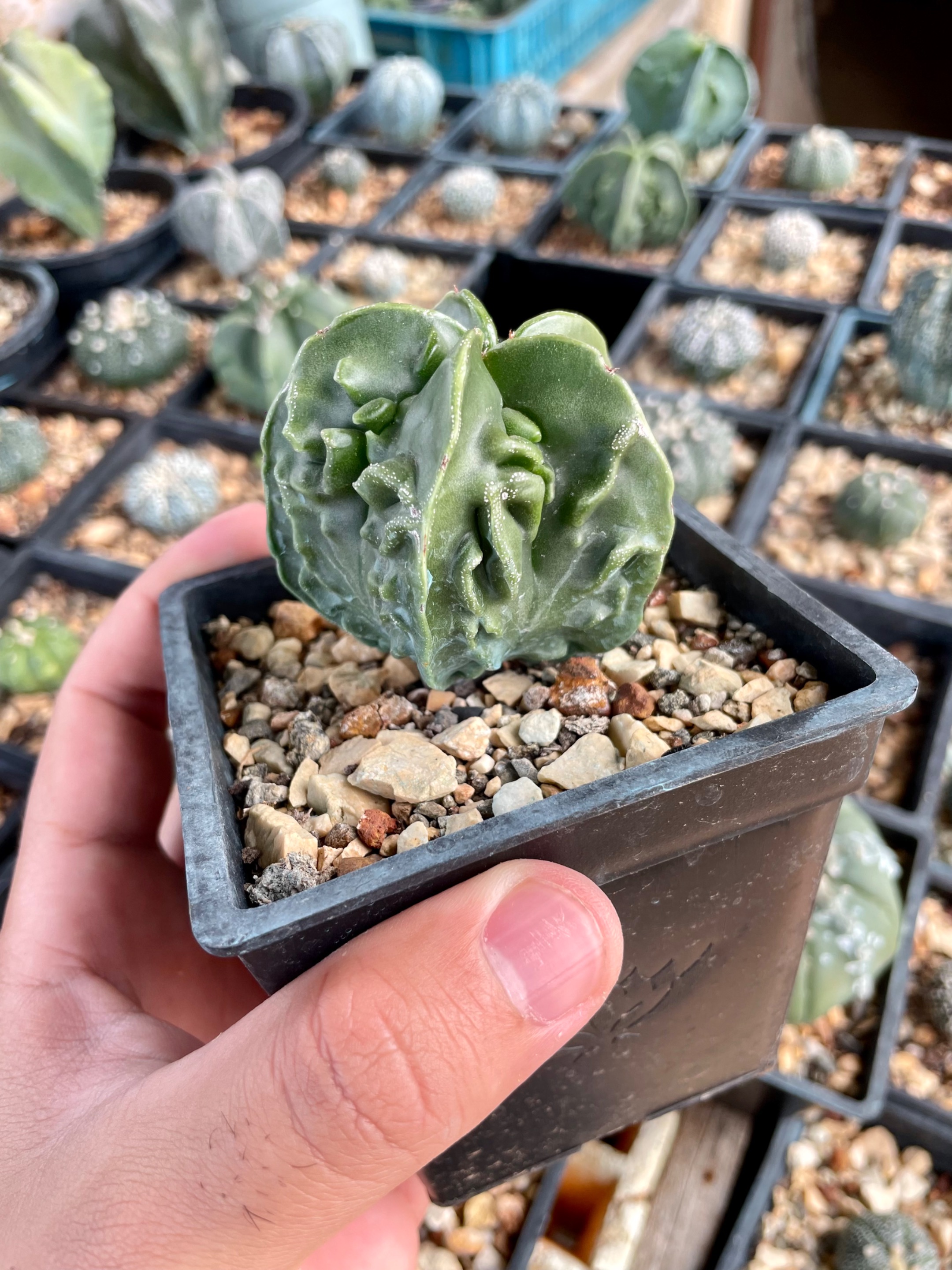
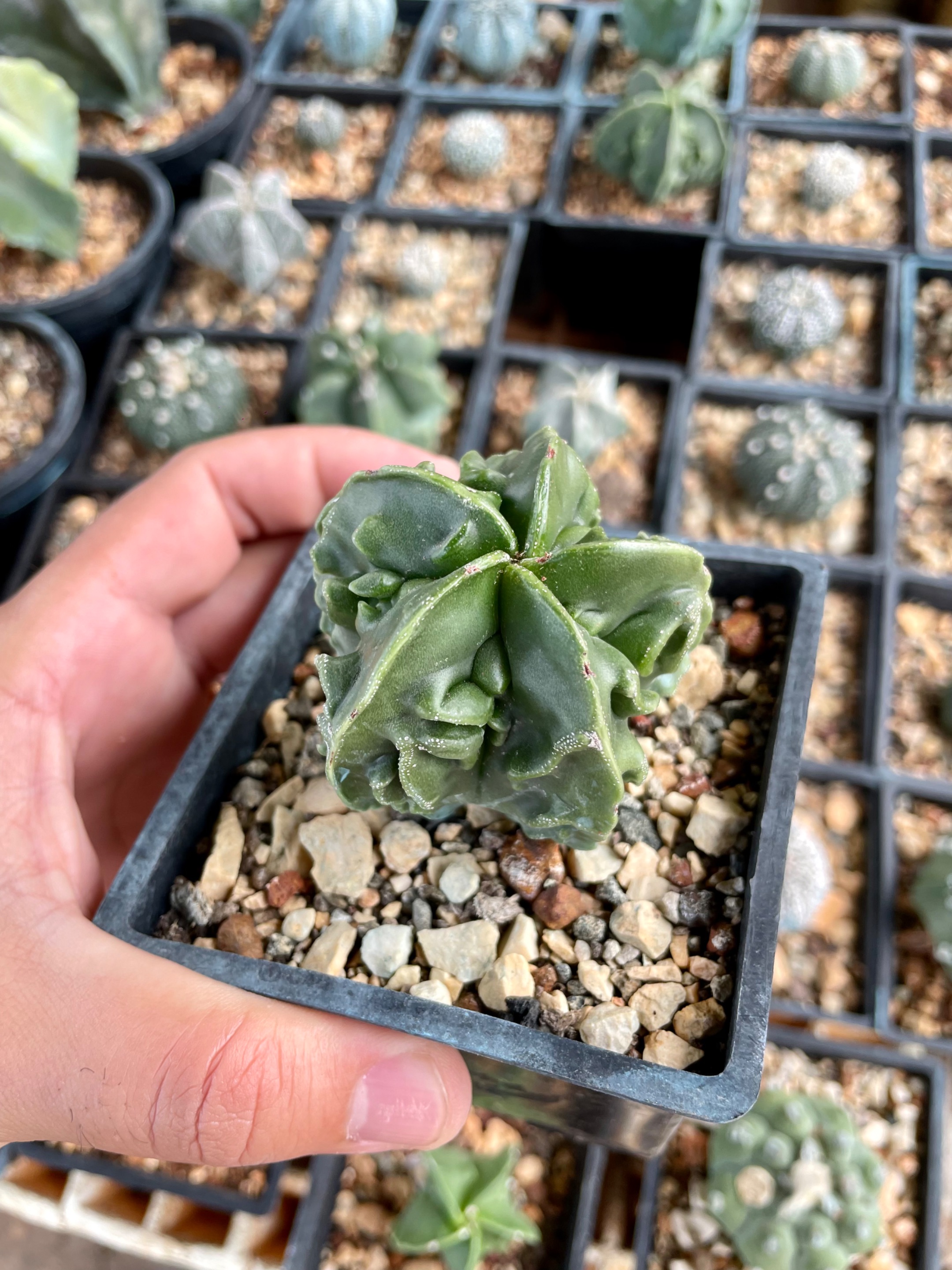
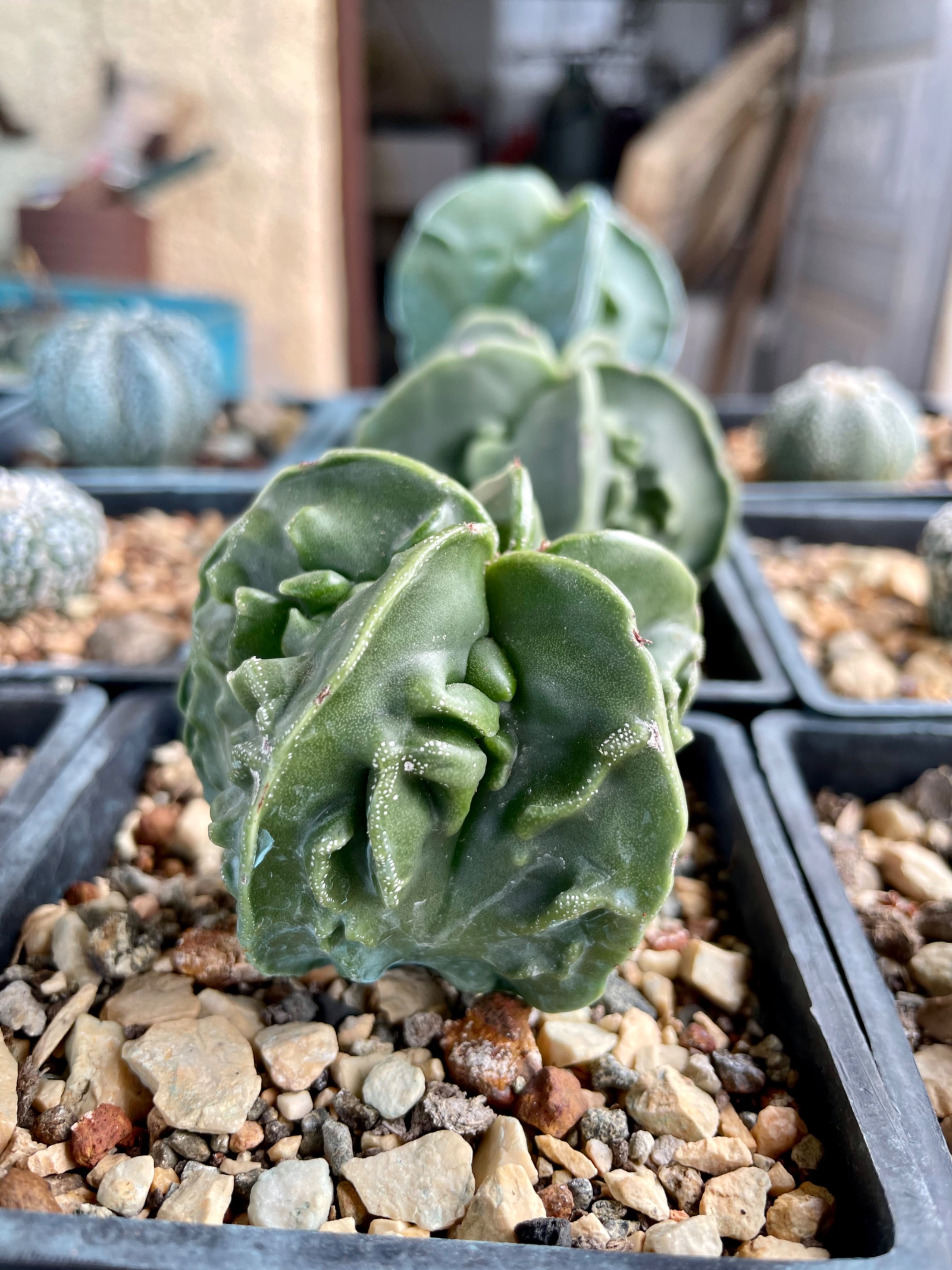
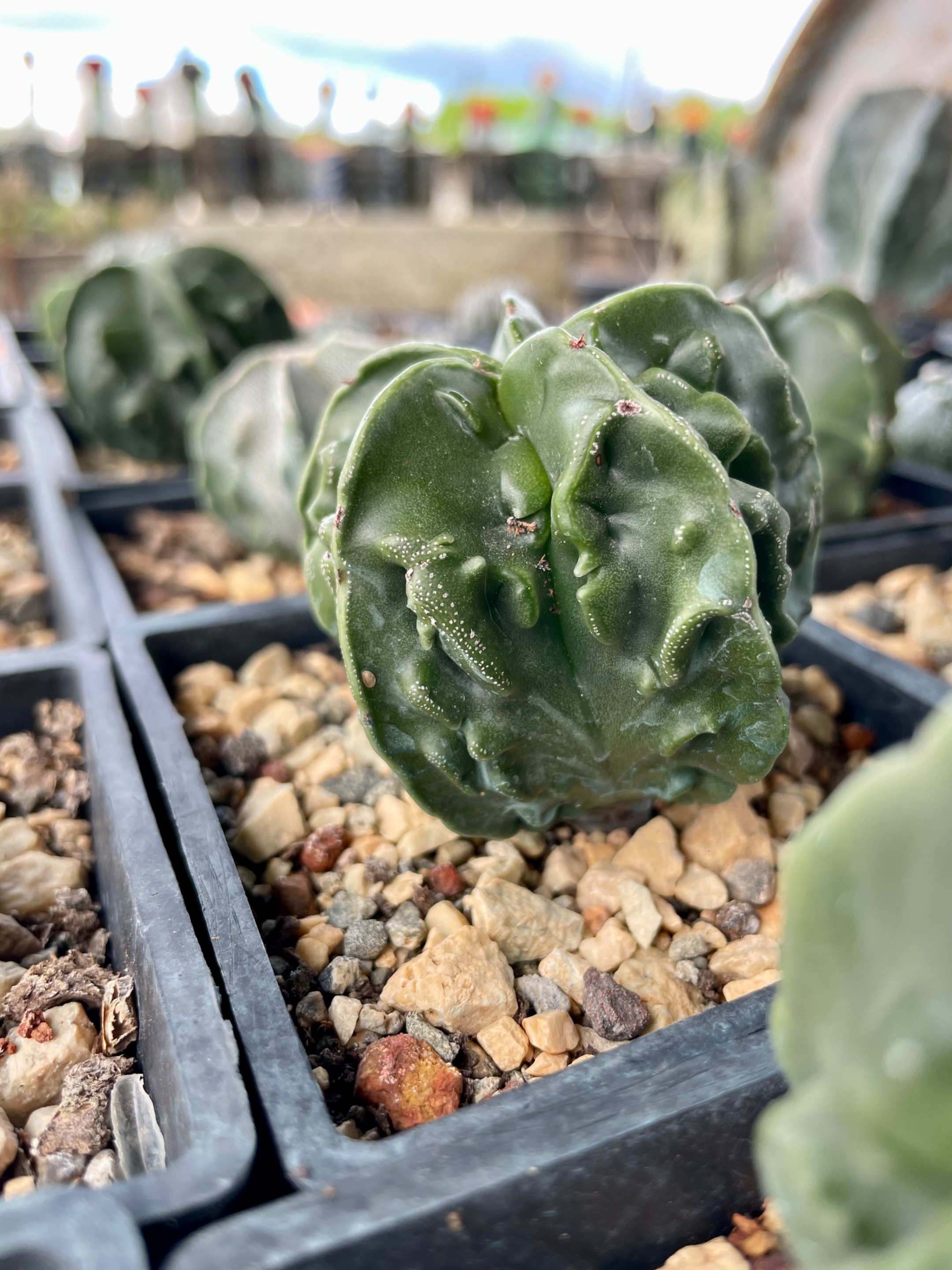 ---
I have about 15 or 16 medium-sized Fukuryu and about a hundred more in seedbeds. They are very grateful for the environment in Cuba 🇨🇺. They like well-drained, fertile, and loose soil. For cultivation, you can use specific cactus soil or a mixed soil.
---
I have about 15 or 16 medium-sized Fukuryu and about a hundred more in seedbeds. They are very grateful for the environment in Cuba 🇨🇺. They like well-drained, fertile, and loose soil. For cultivation, you can use specific cactus soil or a mixed soil.
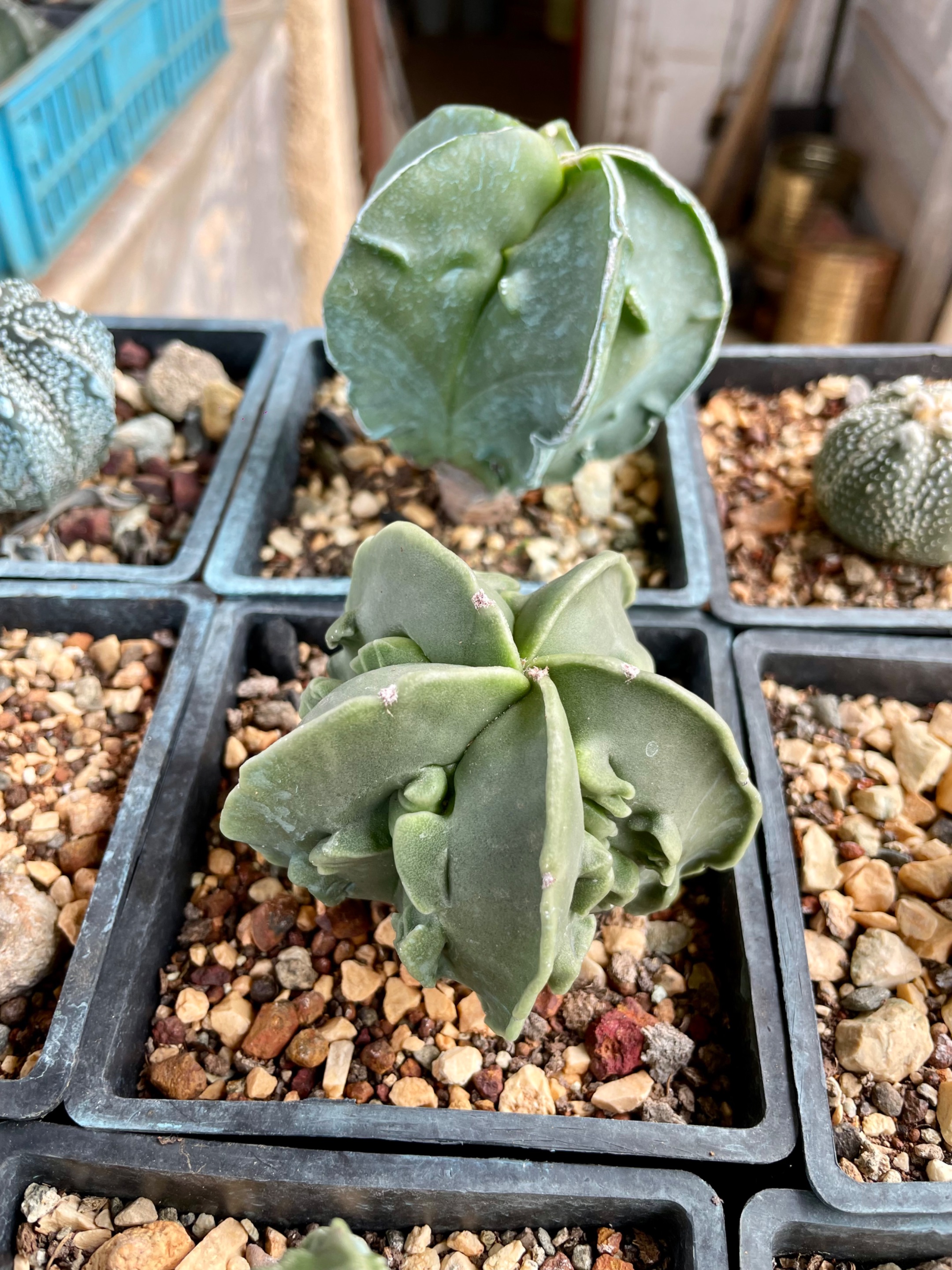
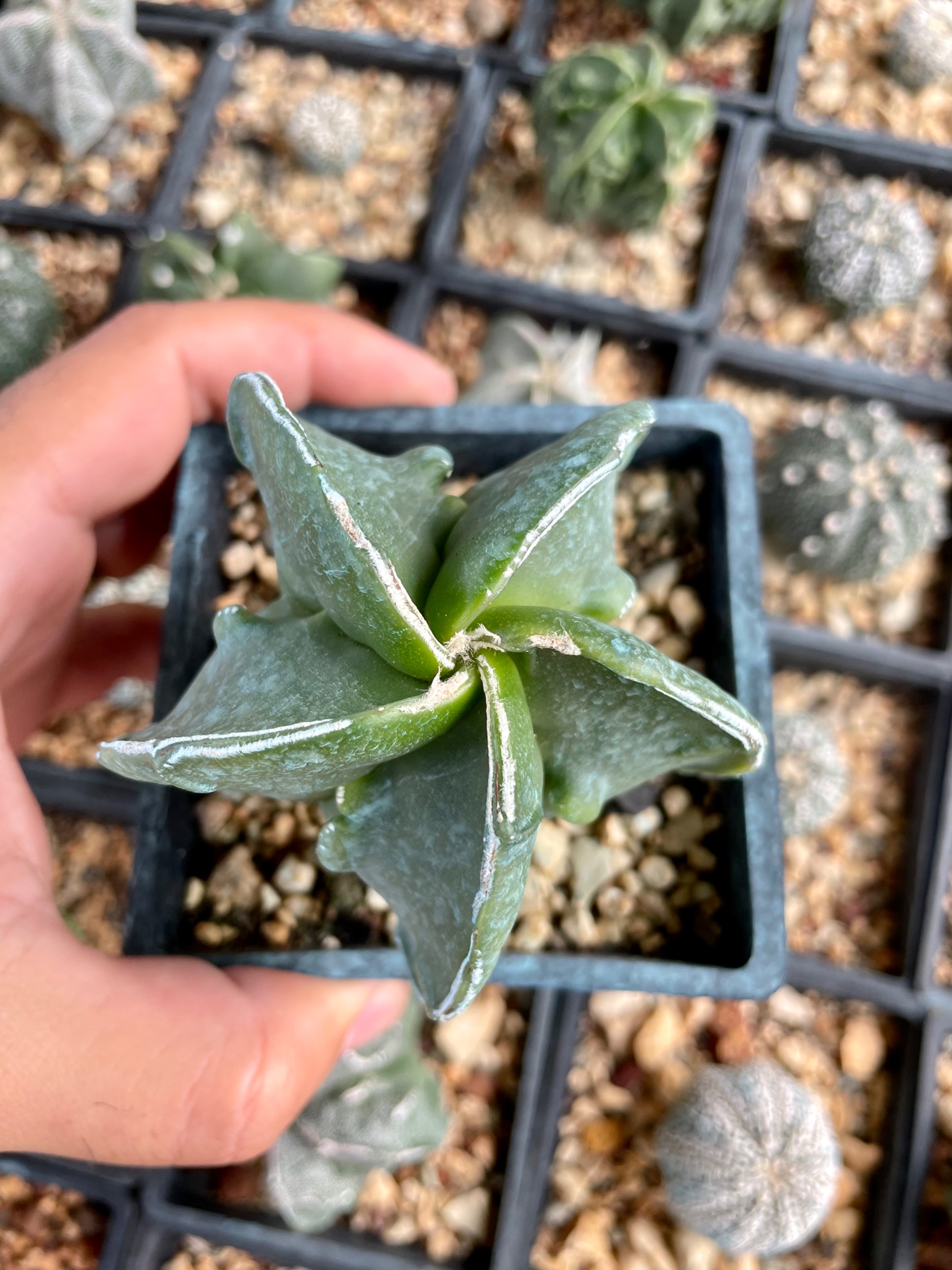
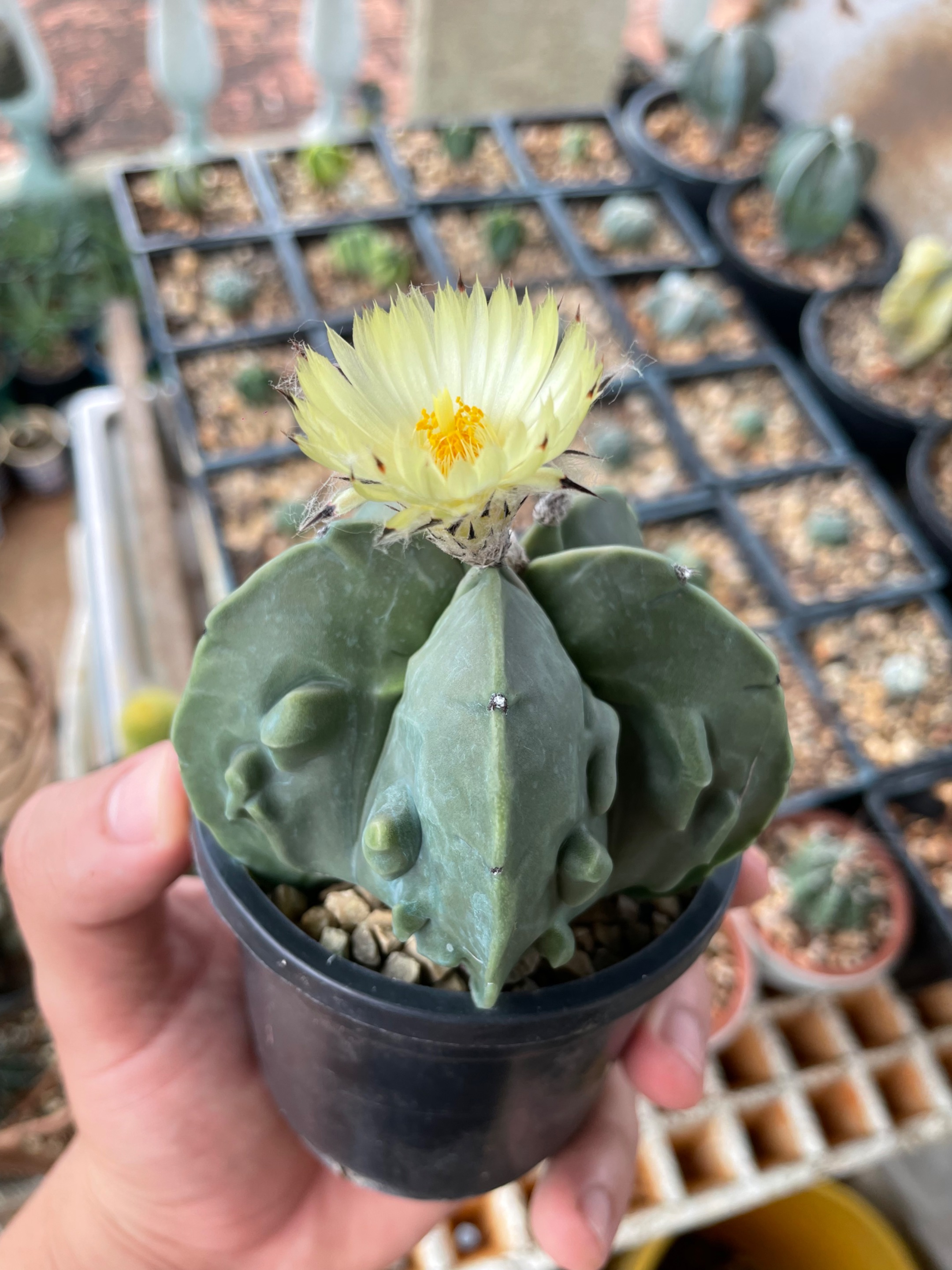 ---
The one you will see is a hybrid and the only one I have with spines. It was a specimen germinated in 2020, right in the middle of the COVID-19 pandemic. During that time of isolation, I dedicated myself to making various crosses between species to obtain unique hybrids.
During the growth period, Fukuryu needs adequate fertilization. A diluted liquid fertilizer or worm humus can be applied once a month.
---
The one you will see is a hybrid and the only one I have with spines. It was a specimen germinated in 2020, right in the middle of the COVID-19 pandemic. During that time of isolation, I dedicated myself to making various crosses between species to obtain unique hybrids.
During the growth period, Fukuryu needs adequate fertilization. A diluted liquid fertilizer or worm humus can be applied once a month.
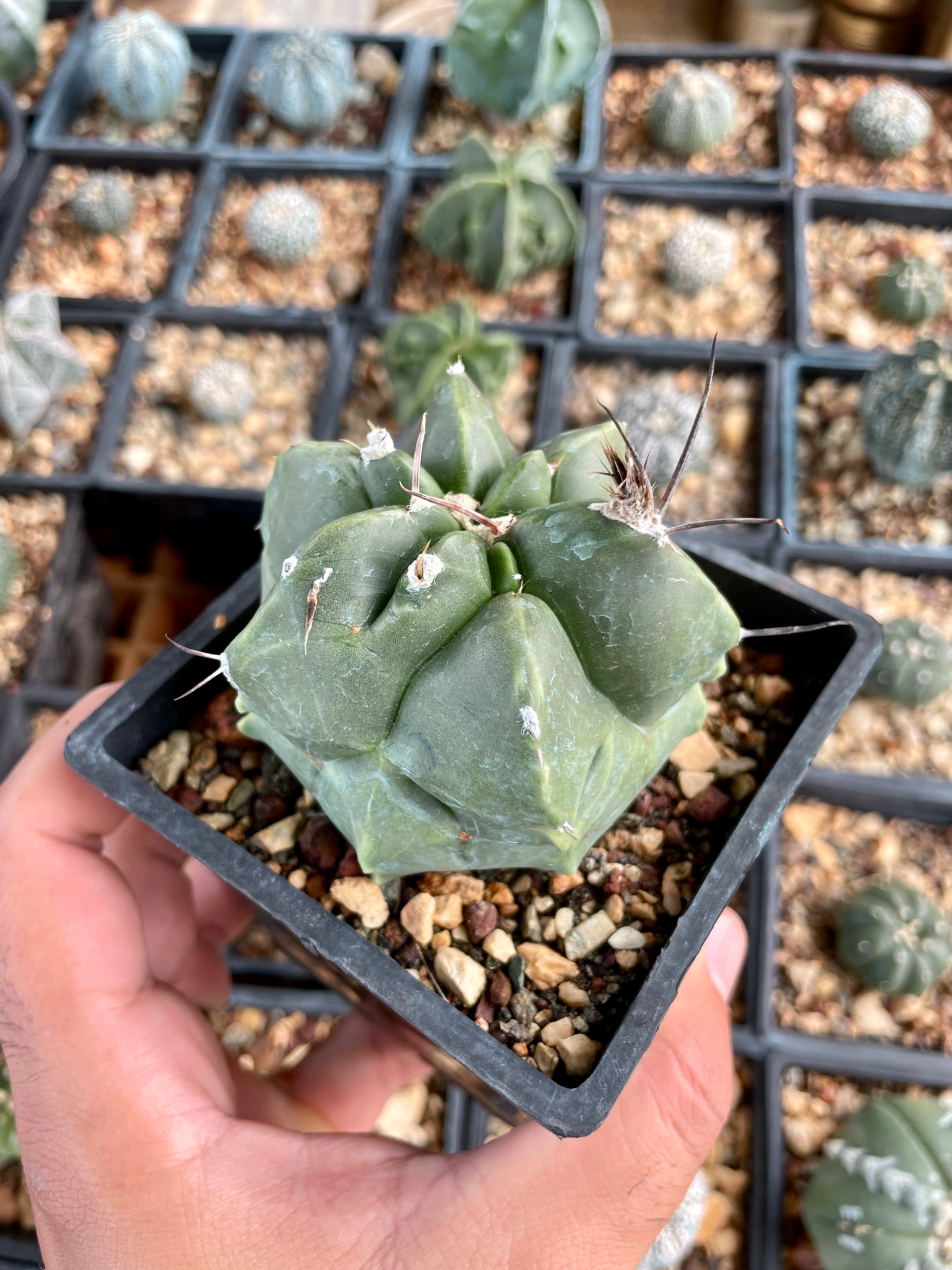
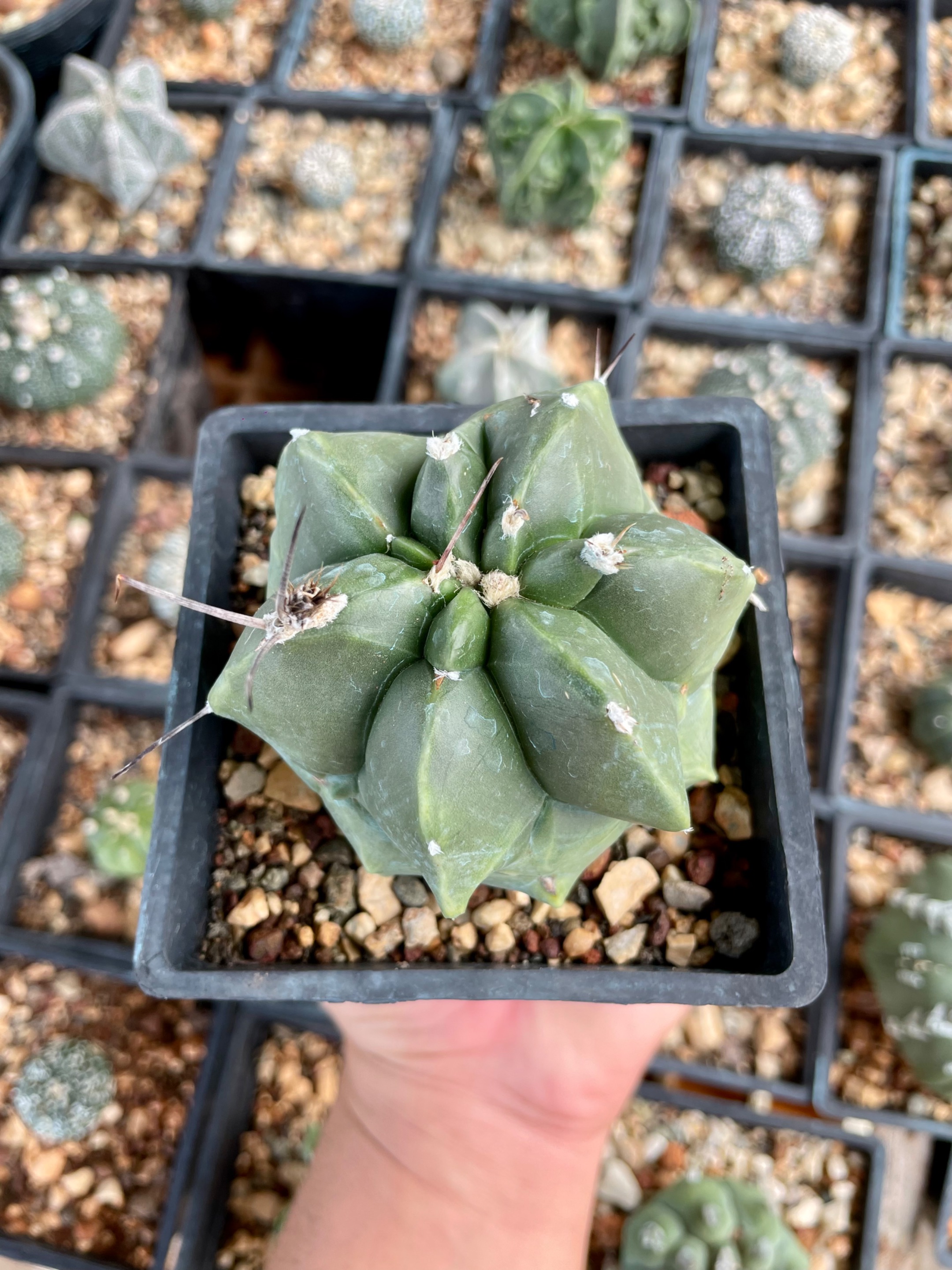 ---
It is suitable for them to grow at temperatures between 15-25 degrees Celsius. In winter, attention must be paid to maintaining warmth to protect them from low temperatures. For the most part, throughout the entire period, I keep them with a little water every 15 days.
---
It is suitable for them to grow at temperatures between 15-25 degrees Celsius. In winter, attention must be paid to maintaining warmth to protect them from low temperatures. For the most part, throughout the entire period, I keep them with a little water every 15 days.
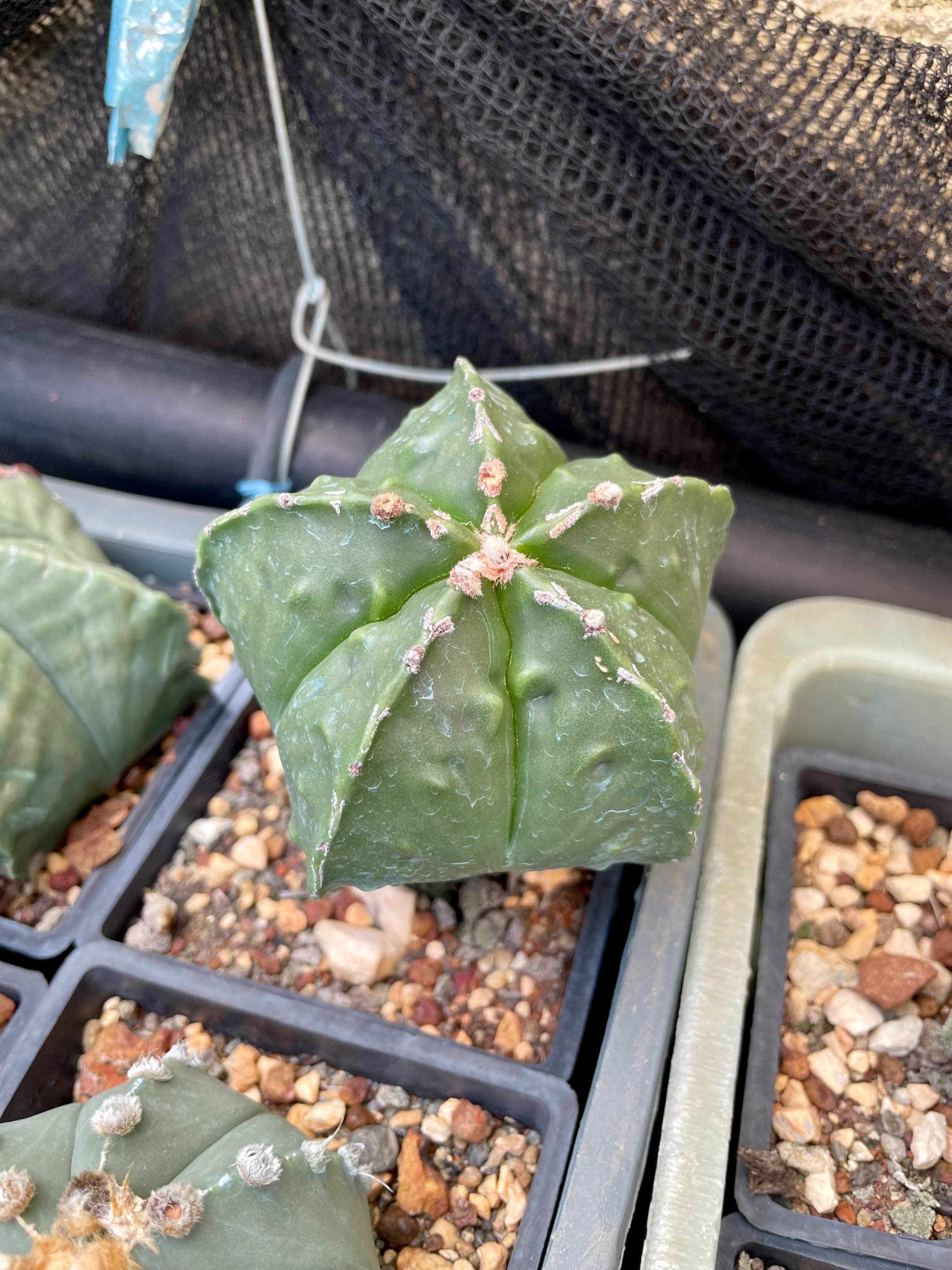
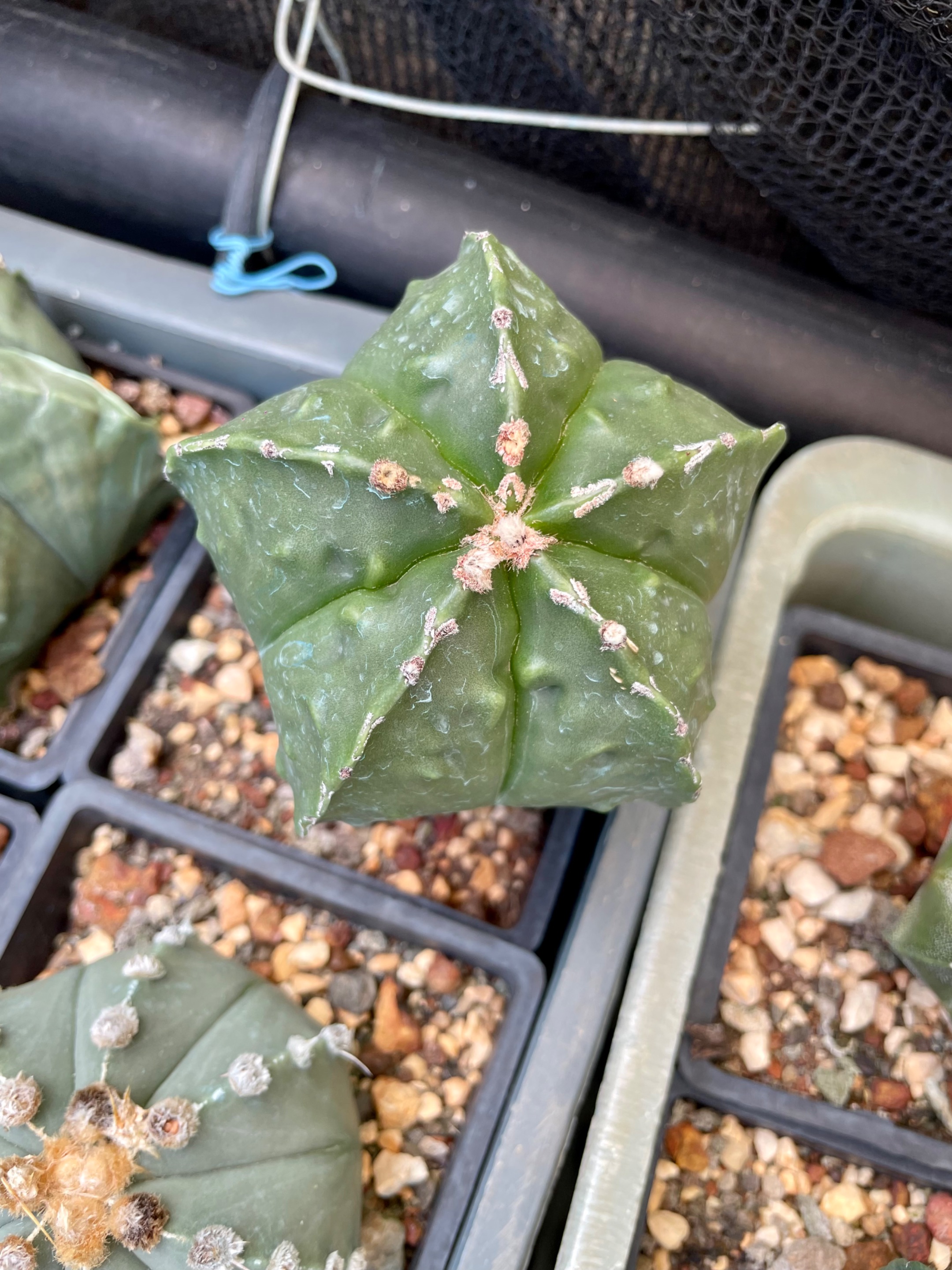
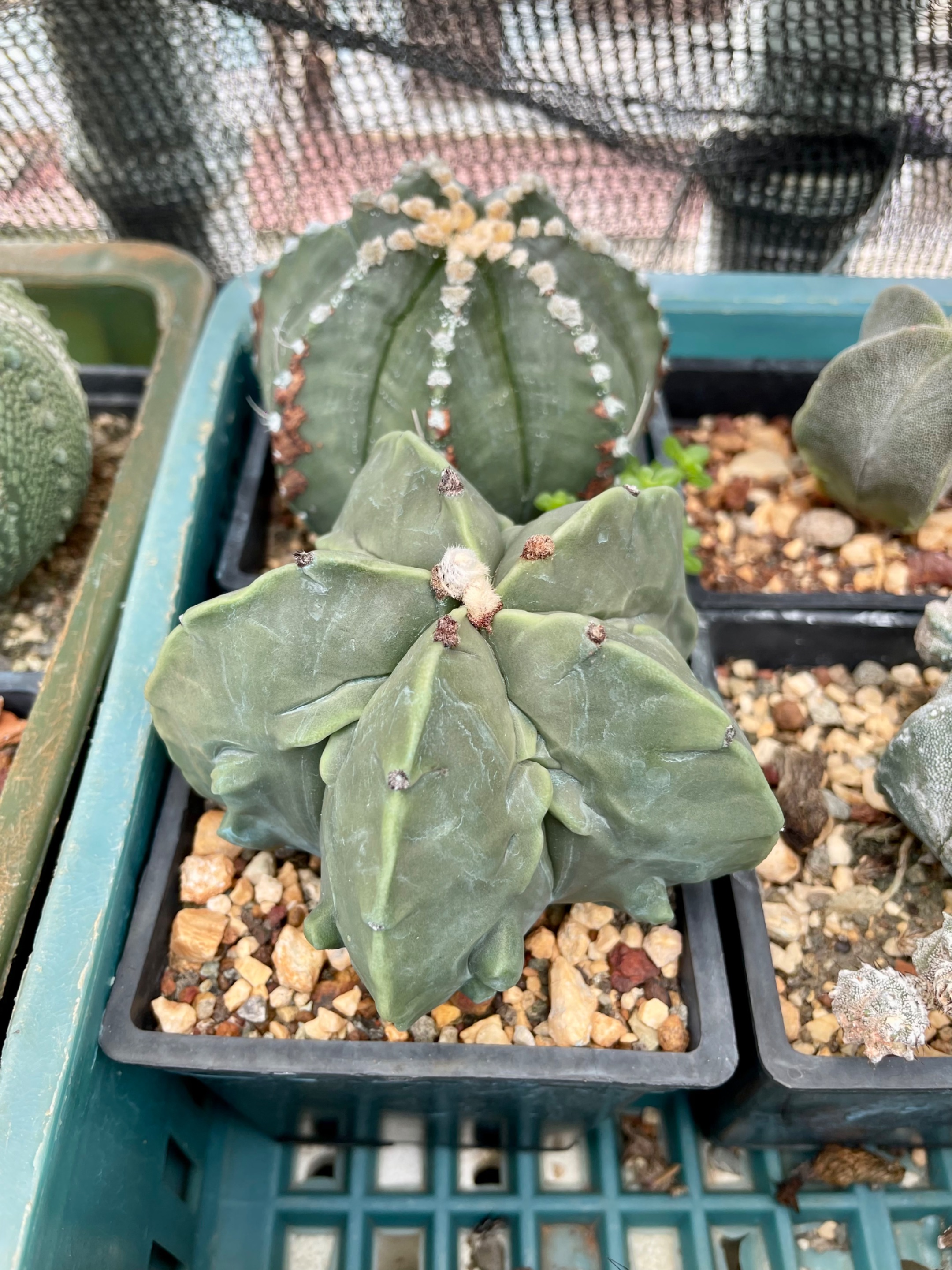 ---
This is the one with the most ribs or warts in the entire garden; it is unique of its kind, although I have been obtaining seeds from it by crossing it with other Fukuryus for several months now.
Another important point is repotting once a year. When repotting, you can remove the old soil, add new soil, and properly prune the root system, which greatly benefits the plant's health.
---
This is the one with the most ribs or warts in the entire garden; it is unique of its kind, although I have been obtaining seeds from it by crossing it with other Fukuryus for several months now.
Another important point is repotting once a year. When repotting, you can remove the old soil, add new soil, and properly prune the root system, which greatly benefits the plant's health.
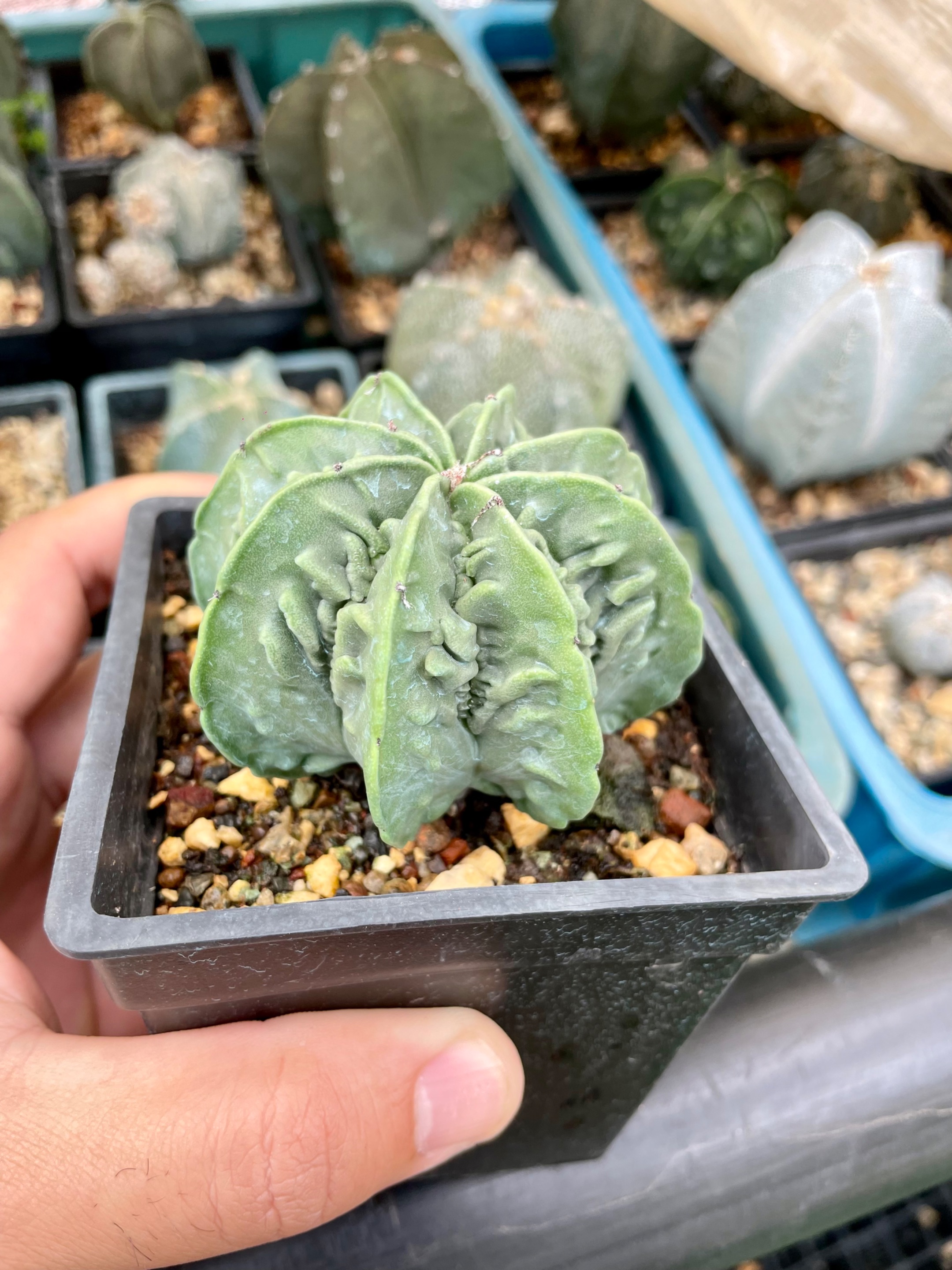
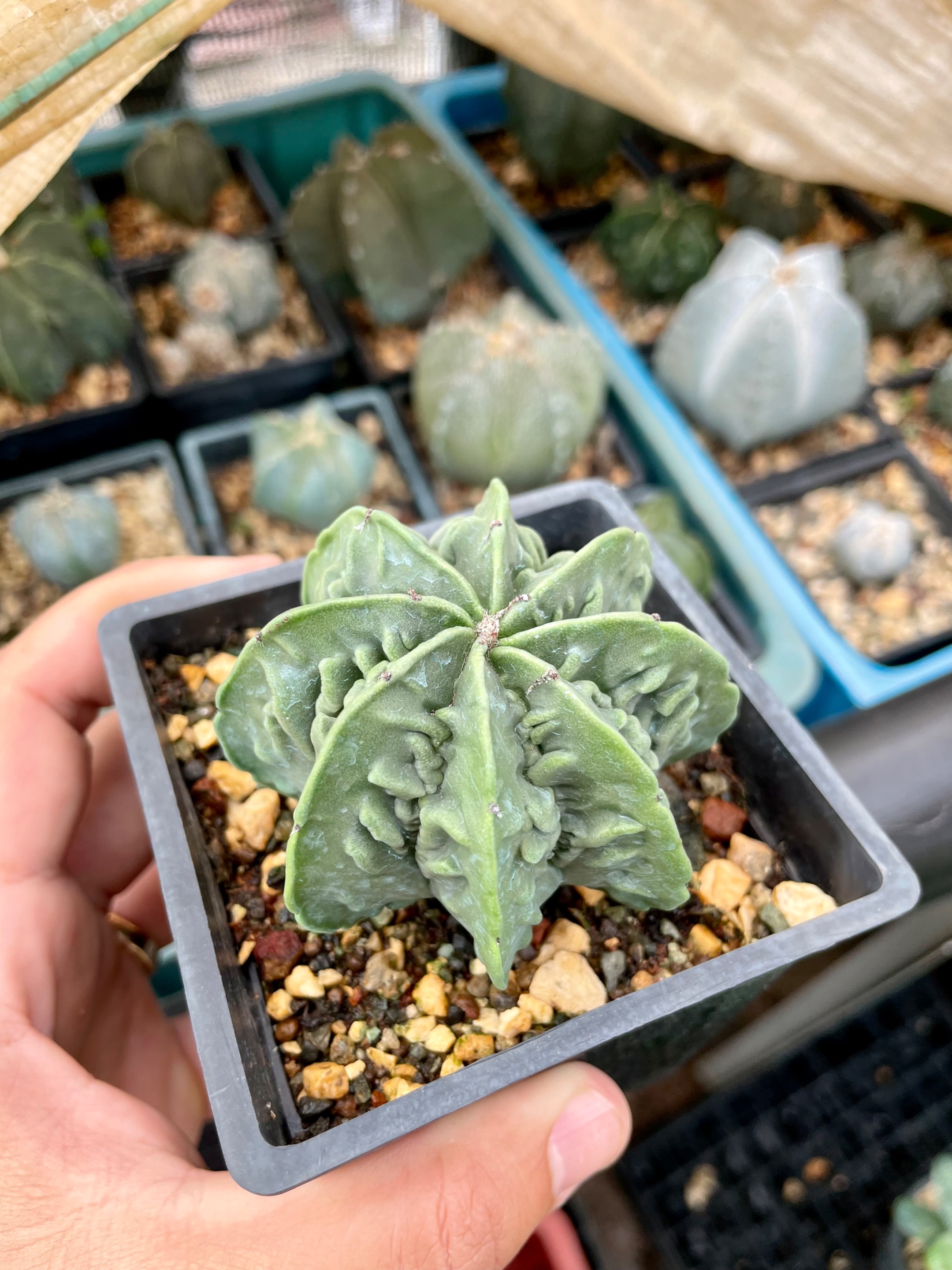 ---
This is a perfect cactus for collectors who seek specimens with their own unique personality and who enjoy variability and unconventional beauty in their succulents.
---
This is a perfect cactus for collectors who seek specimens with their own unique personality and who enjoy variability and unconventional beauty in their succulents.
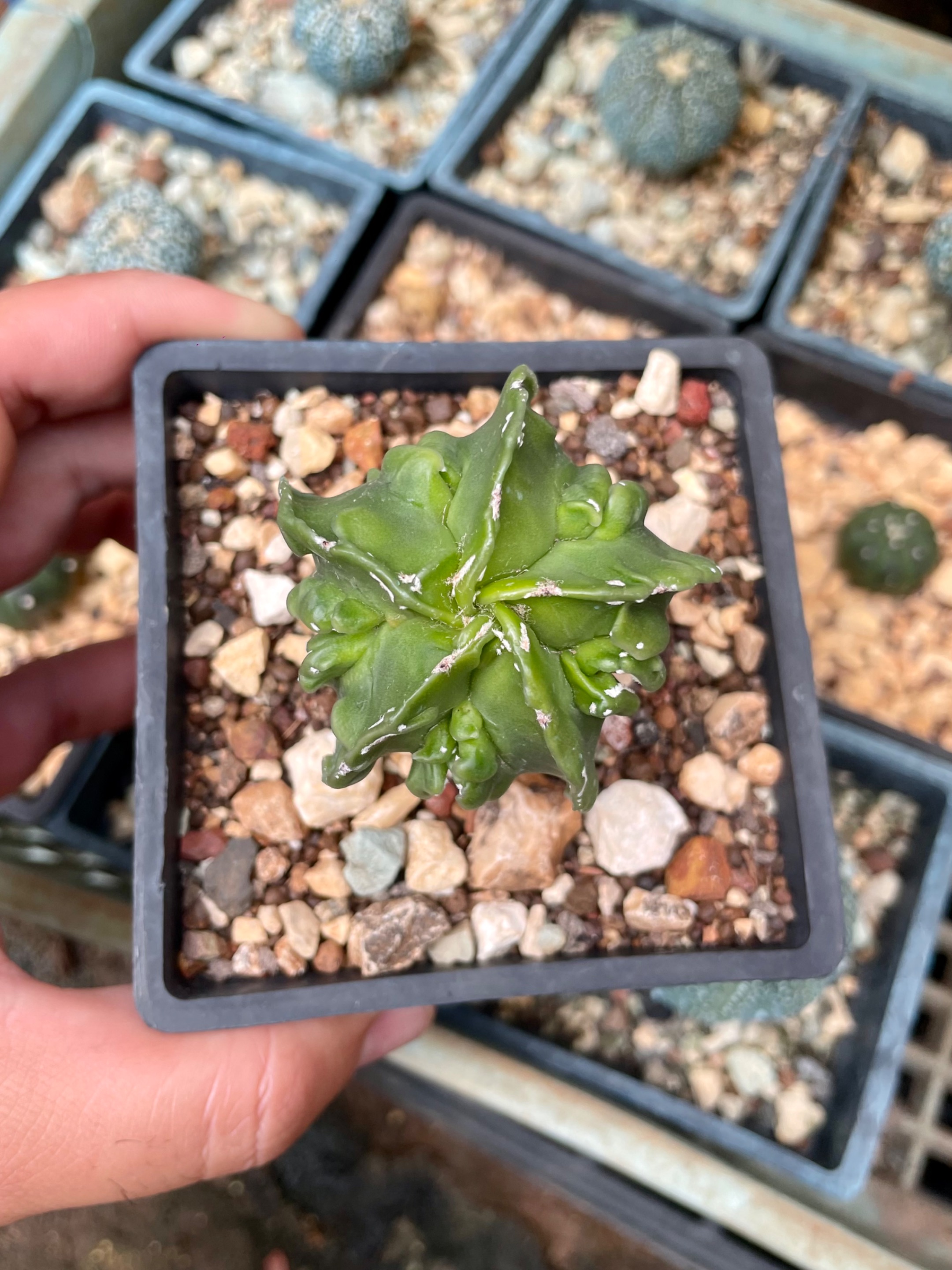
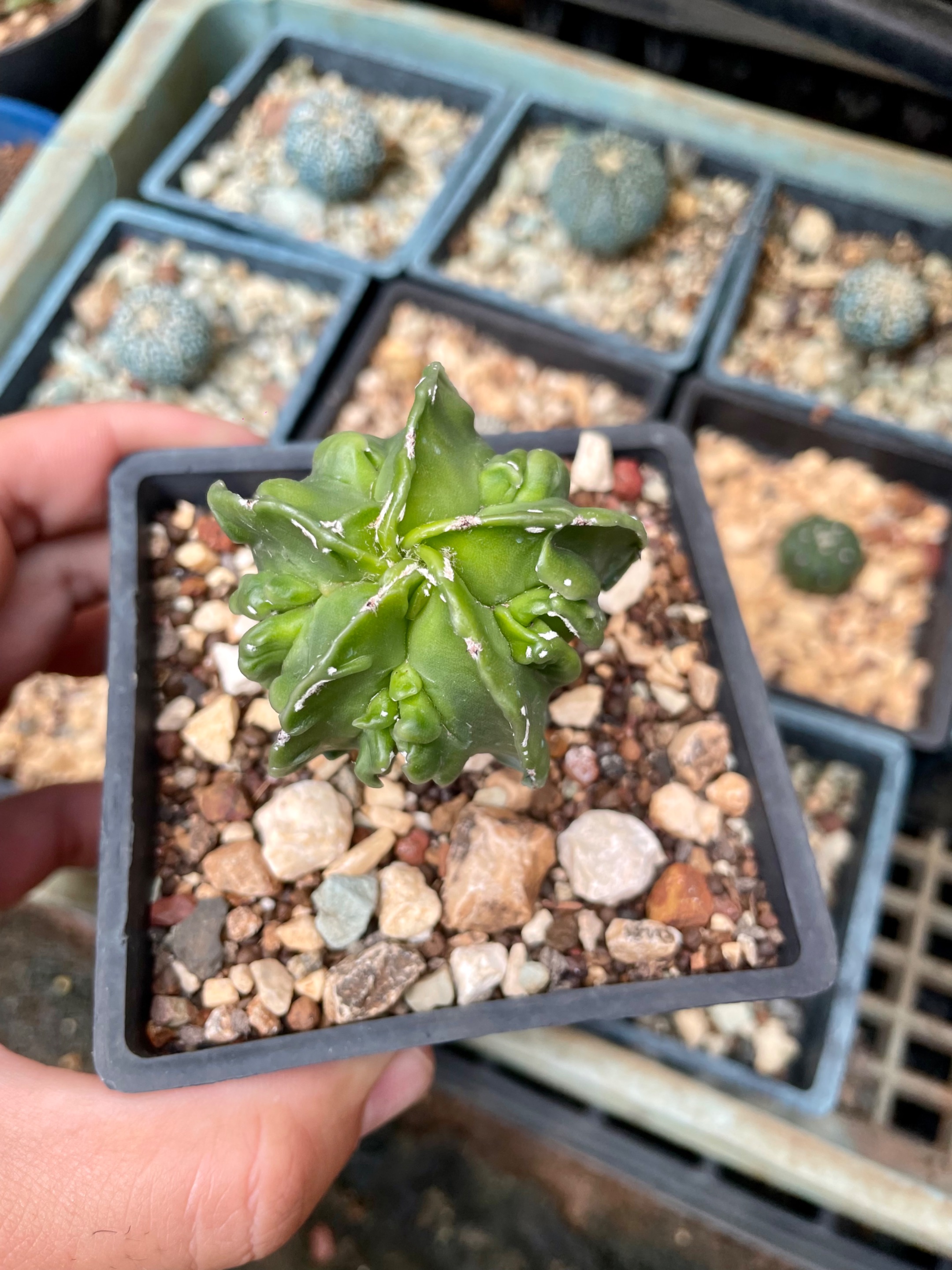 ---
Finally, I'll add that you should watch out for pests like mealybugs, which can hide between the plant's bumps.
---
Finally, I'll add that you should watch out for pests like mealybugs, which can hide between the plant's bumps.
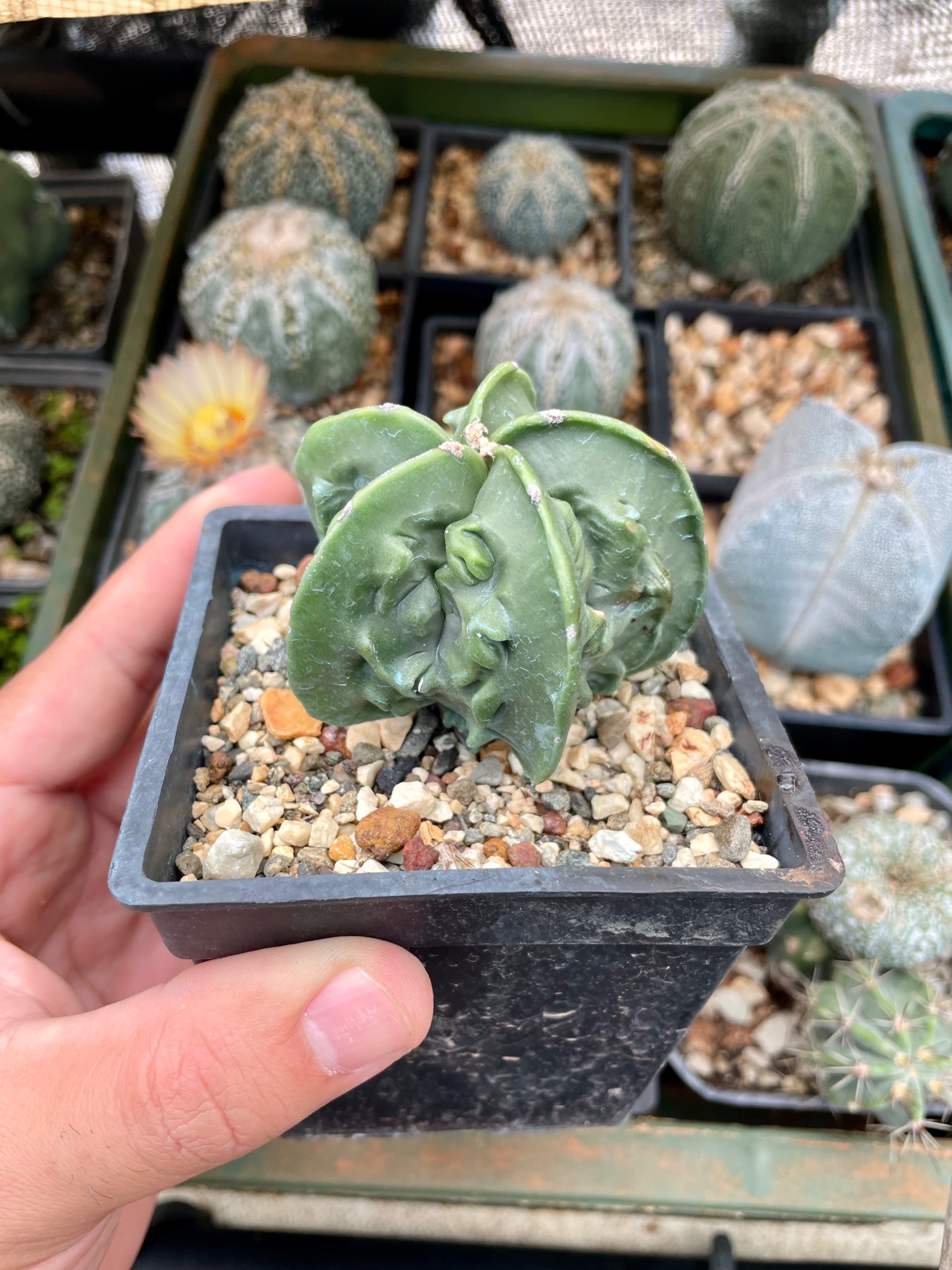
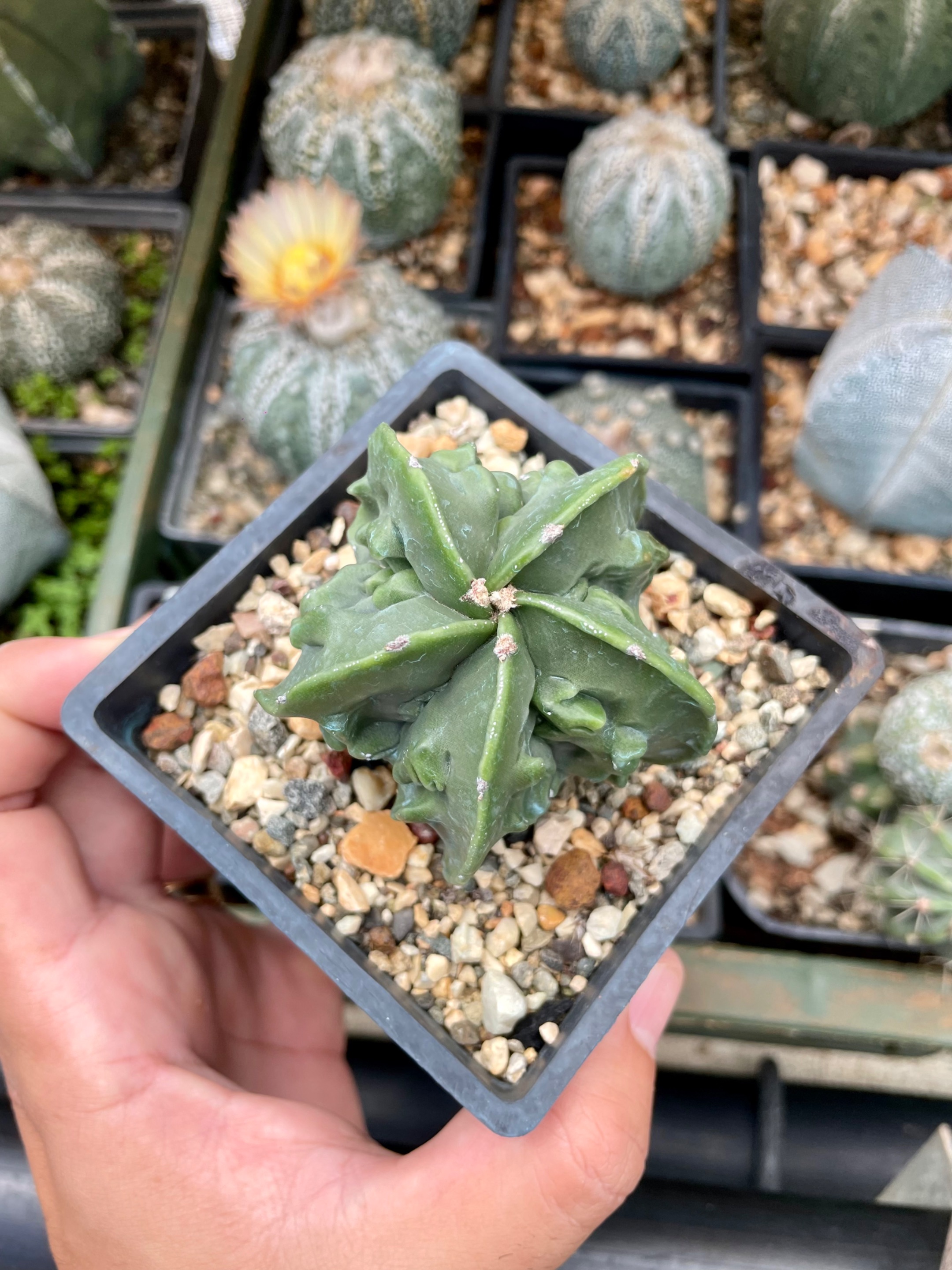
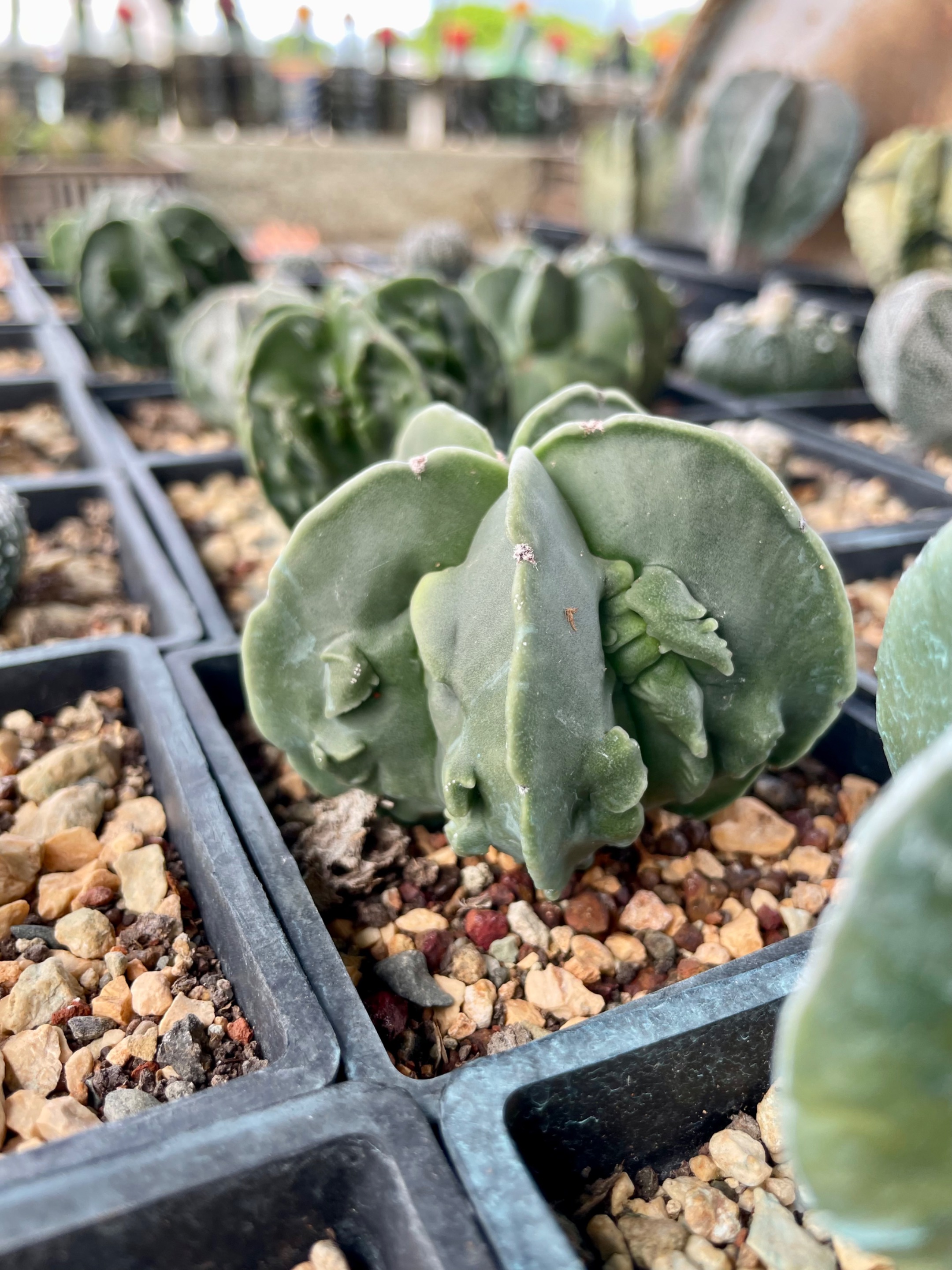 ---
That's all for today. I hope you enjoyed this beautiful variety of cactus, its flowers, the photographs, and learning a bit about Astrophytum myriostigma cv. Fukuryu in general. If you liked it, don't forget to leave a comment and follow me for future posts. I would love to hear your opinions and ideas for the next one.
Do you have any of these species in your garden? Tell me, which one from the collection is your favorite?
---
That's all for today. I hope you enjoyed this beautiful variety of cactus, its flowers, the photographs, and learning a bit about Astrophytum myriostigma cv. Fukuryu in general. If you liked it, don't forget to leave a comment and follow me for future posts. I would love to hear your opinions and ideas for the next one.
Do you have any of these species in your garden? Tell me, which one from the collection is your favorite?
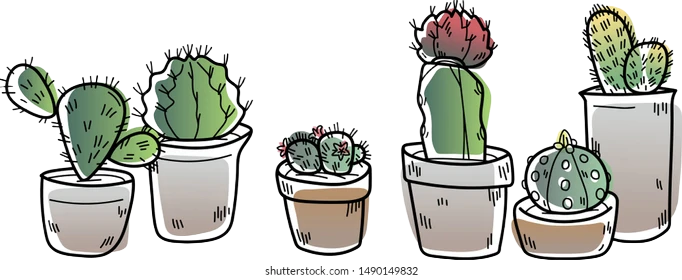

 Todas las fotos fueron tomadas por mi IPhone 12 Pro y editadas en InShot. El Inglés no es mi idioma nativo, usé www.DeepL.com/Translator.
All photos were taken by my IPhone 12 Pro and edited at InShot. English is not my native language, I used www.DeepL.com/Translator.
Todas las fotos fueron tomadas por mi IPhone 12 Pro y editadas en InShot. El Inglés no es mi idioma nativo, usé www.DeepL.com/Translator.
All photos were taken by my IPhone 12 Pro and edited at InShot. English is not my native language, I used www.DeepL.com/Translator.
Hola…. Buenas Noches amantes de las plantas y suculentas !! Llevaba días con ansias de publicar con ustedes la comunidad de Succulent Growers a cargo de @nikv. Hoy quiero compartir algunas especies de mi colección de Astrophytum myriostigma cv. Fukuryu, entre ellas las más apreciadas y curiosas del jardín. Sólo espero que sea del agrado de todos y que disfruten de algunas de las siguientes imágenes. 🤗---

 ---
Astrophytum myriostigma cv. Fukuryu often have a unique and exceptional shape. As I mentioned in previous posts, these exotic, star-shaped and globular cacti—which become columnar over time—are loved by collectors. The name of this variety, Fukuryu comes from a Japanese word meaning "the presence of extra ribs," and it can be found in two very distinct forms:
Type A: With small, additional ribs that do not reach the plant's apex and develop between its true ribs.
Type B: The plant has many more ribs or warts between and on its surface.
---
Astrophytum myriostigma cv. Fukuryu often have a unique and exceptional shape. As I mentioned in previous posts, these exotic, star-shaped and globular cacti—which become columnar over time—are loved by collectors. The name of this variety, Fukuryu comes from a Japanese word meaning "the presence of extra ribs," and it can be found in two very distinct forms:
Type A: With small, additional ribs that do not reach the plant's apex and develop between its true ribs.
Type B: The plant has many more ribs or warts between and on its surface.
Los Astrophytum myriostigma cv. Fukuryu suelen tener una forma única y excepcional. Como les había mencionado en posts anteriores estos cactus exóticos en forma de estrellas y globulares que con el tiempo se vuelven columnar, son amados por los coleccionistas. El nombre de esta variedad fukuryu proviene de una palabra japonesa la cual significa presencia de costillas adicionales (costas) y se puede encontrar de dos formas muy distintas: Tipo A: Con pequeñas costillas adicionales que no alcanzan el ápice de la planta y se desarrollan entre las verdaderas costillas de la planta. Tipo B: La planta tiene muchas mas costillas o verrugas entre y sobre la superficie.---

 ---
Many of these Astrophytum are germinated and cultivated from seeds in my nursery. As you can see, their areoles are usually small and they may have no spines or just a few short ones.
They break the perfect geometry of the common myriostigma, giving it a rugged, monstrous look that can perfectly resemble the scales on a dragon's back.
---
Many of these Astrophytum are germinated and cultivated from seeds in my nursery. As you can see, their areoles are usually small and they may have no spines or just a few short ones.
They break the perfect geometry of the common myriostigma, giving it a rugged, monstrous look that can perfectly resemble the scales on a dragon's back.
Muchos de estos Astrophytum, son germinado y cultivados por semillas en mi vivero. Como pueden observar sus areolas suelen ser pequeñas y pueden no tener espinas o solo unas pocas espinas cortas. Rompen la geometría perfecta del myrostigma común, dándole un aspecto rugoso y monstruoso, que perfectamente pueden parecerse a las escamas del lomo de un dragón.---


 ---
Fukuryu flowers can be relatively large, funnel-shaped, and come in shades of yellow, orange, red, etc. They bloom during sunny seasons like spring and summer, but direct contact with the plant should be avoided.
They are drought-tolerant. However, during the growing period, adequate watering is necessary to keep the soil moist. In winter, it is best to reduce watering to prevent water accumulation and root rot.
---
Fukuryu flowers can be relatively large, funnel-shaped, and come in shades of yellow, orange, red, etc. They bloom during sunny seasons like spring and summer, but direct contact with the plant should be avoided.
They are drought-tolerant. However, during the growing period, adequate watering is necessary to keep the soil moist. In winter, it is best to reduce watering to prevent water accumulation and root rot.
Las flores de Fukuryu pueden ser relativamente grandes, con forma de embudo y de tonalidades amarillas, naranjas o rojas, etc. Florecen en épocas de mucho sol como la primavera y verano, pero evitando el contacto directo con la planta. Son tolerante a la sequía. Sin embargo, durante el período de crecimiento, es necesario un riego adecuado para mantener la tierra húmeda. En invierno conviene reducir los riegos para evitar la acumulación de agua y la pudrición de las raíces.---



 ---
I have about 15 or 16 medium-sized Fukuryu and about a hundred more in seedbeds. They are very grateful for the environment in Cuba 🇨🇺. They like well-drained, fertile, and loose soil. For cultivation, you can use specific cactus soil or a mixed soil.
---
I have about 15 or 16 medium-sized Fukuryu and about a hundred more in seedbeds. They are very grateful for the environment in Cuba 🇨🇺. They like well-drained, fertile, and loose soil. For cultivation, you can use specific cactus soil or a mixed soil.
Tengo alrededor de 15 o 16 fukuryu medianos y en semilleros una centena, son muy agradecidos con el ambiente de cuba 🇨🇺. Le gustan los suelos bien drenados, fértiles y sueltos. Para el cultivo se puede utilizar tierra específica para cactus o tierra mixta.---


 ---
The one you will see is a hybrid and the only one I have with spines. It was a specimen germinated in 2020, right in the middle of the COVID-19 pandemic. During that time of isolation, I dedicated myself to making various crosses between species to obtain unique hybrids.
During the growth period, Fukuryu needs adequate fertilization. A diluted liquid fertilizer or worm humus can be applied once a month.
---
The one you will see is a hybrid and the only one I have with spines. It was a specimen germinated in 2020, right in the middle of the COVID-19 pandemic. During that time of isolation, I dedicated myself to making various crosses between species to obtain unique hybrids.
During the growth period, Fukuryu needs adequate fertilization. A diluted liquid fertilizer or worm humus can be applied once a month.
Este que verán es un híbrido y el único que contengo con espinas, fue un ejemplar germinado en el 2020 en pleno COVID-19. En esa época de aislamiento, me dediqué a realizar varias mezclas entre especies y obtener híbridos únicos. Durante el período de crecimiento, Fukuryu necesita una fertilización adecuada. Se puede aplicar un fertilizante líquido diluido una vez al mes o humus de lombriz.---

 ---
It is suitable for them to grow at temperatures between 15-25 degrees Celsius. In winter, attention must be paid to maintaining warmth to protect them from low temperatures. For the most part, throughout the entire period, I keep them with a little water every 15 days.
---
It is suitable for them to grow at temperatures between 15-25 degrees Celsius. In winter, attention must be paid to maintaining warmth to protect them from low temperatures. For the most part, throughout the entire period, I keep them with a little water every 15 days.
Es adecuado que crezcan a temperaturas entre 15-25 grados. En invierno se debe prestar atención a mantener el calor para evitar las bajas temperaturas, mayormente durante todo el período los mantengo con agua cada 15 días un poco.---


 ---
This is the one with the most ribs or warts in the entire garden; it is unique of its kind, although I have been obtaining seeds from it by crossing it with other Fukuryus for several months now.
Another important point is repotting once a year. When repotting, you can remove the old soil, add new soil, and properly prune the root system, which greatly benefits the plant's health.
---
This is the one with the most ribs or warts in the entire garden; it is unique of its kind, although I have been obtaining seeds from it by crossing it with other Fukuryus for several months now.
Another important point is repotting once a year. When repotting, you can remove the old soil, add new soil, and properly prune the root system, which greatly benefits the plant's health.
Esta es la que más costillas o verrugas presenta en todo el jardín, es única en su tipo, aunque ya llevo varios meses obteniéndole semillas con otros fukuryus. Otro dato importante es el trasplanta una vez al año. Al trasplantar, se puede quitar la tierra vieja, agregar tierra nueva y podar adecuadamente el sistema de raíces, ayuda mucho a la salud de la planta.---

 ---
This is a perfect cactus for collectors who seek specimens with their own unique personality and who enjoy variability and unconventional beauty in their succulents.
---
This is a perfect cactus for collectors who seek specimens with their own unique personality and who enjoy variability and unconventional beauty in their succulents.
Es un cactus perfecto para coleccionistas que buscan ejemplares con personalidad propia y que disfrutan de la variabilidad y la belleza no convencional en sus suculentas.---

 ---
Finally, I'll add that you should watch out for pests like mealybugs, which can hide between the plant's bumps.
---
Finally, I'll add that you should watch out for pests like mealybugs, which can hide between the plant's bumps.
Por último, les añadiré que estén atentos a las Plagas como la cochinilla algodonosa, que pueden esconderse entre las protuberancias de la planta.So, what do you think @nikv @sacra97 @sanjeevm @solominer @mysteriousroad @riverflows @akipponn @anggreklestari @isdarmady @ewkaw of these Astrophytum myriostigma cv. Fukuryu?? Do any of you have them in your collections?? 😊🙏🏻 #hivegarden #cacti ---


 ---
That's all for today. I hope you enjoyed this beautiful variety of cactus, its flowers, the photographs, and learning a bit about Astrophytum myriostigma cv. Fukuryu in general. If you liked it, don't forget to leave a comment and follow me for future posts. I would love to hear your opinions and ideas for the next one.
Do you have any of these species in your garden? Tell me, which one from the collection is your favorite?
---
That's all for today. I hope you enjoyed this beautiful variety of cactus, its flowers, the photographs, and learning a bit about Astrophytum myriostigma cv. Fukuryu in general. If you liked it, don't forget to leave a comment and follow me for future posts. I would love to hear your opinions and ideas for the next one.
Do you have any of these species in your garden? Tell me, which one from the collection is your favorite?
Esto a sido todo por hoy, espero hayan disfrutado de esta hermosa variedad de cactus, su flor, fotografías y aprendiendo un poco de los Astrophytum myriostigma cv. Fukuryu en general. Si te ha gustado, no olvides dejar tu comentario y seguirme para próximas publicaciones. Me encantaría saber tu opinión e ideas para el siguiente. ¿Poseen alguna especie en su jardín? ¿Dime cuál es tu favorito de la colección?---


 Todas las fotos fueron tomadas por mi IPhone 12 Pro y editadas en InShot. El Inglés no es mi idioma nativo, usé www.DeepL.com/Translator.
All photos were taken by my IPhone 12 Pro and edited at InShot. English is not my native language, I used www.DeepL.com/Translator.
Todas las fotos fueron tomadas por mi IPhone 12 Pro y editadas en InShot. El Inglés no es mi idioma nativo, usé www.DeepL.com/Translator.
All photos were taken by my IPhone 12 Pro and edited at InShot. English is not my native language, I used www.DeepL.com/Translator.